#(And basically the entirety of Faust)
Text
Shining Force Pre Release Coverage
yes i have made a post about this before but i was a baby with one magazine. Now i’m a big 90s kid who has gone through the entirety of the Beep Megadrive archives from 1991-1994, as one does. Get ready for what might be my biggest post ever, I don’t wanna break it into parts for the timeline vibe.
To contextualize the following dates: the game came out in Japan on March 1992.
October 1991

More cool sword animations for Max. Also it took me way too long to realize this background is also not anywhere in the final game, though the final Gate of the Ancients bg does take a lot from it. Apparently it was once meant to be an indoor location with torches.

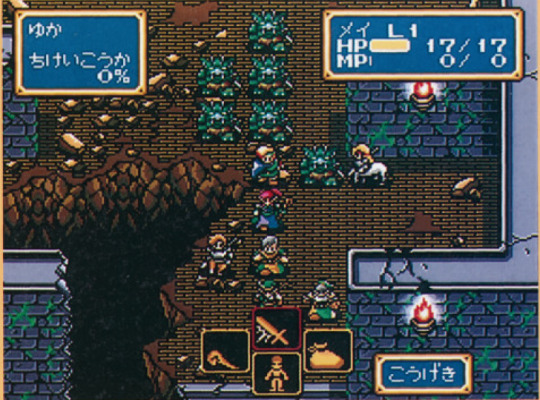
Here are screenshots of the map itself. Icons were completely different, and Gort and Mae are there. Obviously this could be just the use of debug features to test the characters, but I suspect their story roles were actually changed and they were meant to be starting characters. More on that later.

there’s also a screenshot of Guardiana with a slightly different layout. There are centaur NPCs in town as opposed to only in the castle, the old man sprite is different, and the little girls are normal as opposed to dragging cats around. In the final version, this little girl sprite is only for Karin, Krin and Koron, the important little girl trio. The bed sprites are also different and kinda failing at perspective.
Besides screenshots, we also get a synopsis.

Centuries before Mephisto’s uprising in Shining in the Darkness... In the continent of Rune, far to the east of Thornwood, many countries big and small lived in endless days of peace. However, the great nation of Rune Faust, wanting to take over all of Rune, plotted to get its hands on the “Legacy of the Gods” inherited by the country of Guardiana since ancient times.
The Legacy of the Gods is said to be both a superweapon and a frightening beast. Whoever attains it can become a god or a devil... But even though the Rune Faust army has invaded Guardiana and ravaged the country for its plans of domination, it hasn’t succeed in finding the legacy...
Meanwhile, the soldiers of Guardiana, forced into a life of wandering after the fall of their country, have risen to the task of defeating Rune Faust. And as they resist against the unknown evil power controlling Rune Faust, people have come to call them “the forces of light”, Shining Force...
The grassy plains of Guardiana, mountains full of precipices, jungles, deadly deserts, rivers where piranhas live, those and other stages await our heroes.
After all, who is the one controlling the powers of darkness? And what is the truth behind the Legacy of the Gods? Hiding many mysteries, a new legend begins now!!
Very basic stuff, but while it might just the drama vibes, it does feel that Guardiana was supposed to get more wrecked, or get wrecked earlier, which would explain Mae and Gort joining earlier as well. Simone narrating the king’s last wishes right in the intro supports that idea as well.
Lastly, we get some character art and info:

(i know it’s hard to see the og text with this resize but hey, that’s why I linked the magazine collection before)
These are the forces of light, “Shining Force”!
“I’m the swordsman protagonist, Max!”
The protagonist of this story, Max. He’s human, but is an expert with the sword and can also use magic. He roams across the continent, leading the Shining Force in its way to defeat Runefaust.
One more for the “Max was meant to have magic” pile.
Archer - Hans
An elf who used to work at Guardiana’s palace. His skill with the bow is first-class.
Very nitpicky detail: Hans’ class is written with kanji here, when it’s written in katakana in the final version.
Knight - Mae
A young centaur warrior. Daughter of the late Knight Captain.
Priest - Lowe
A dwarf who’s a great friend of Max. Currently training at magic.
Shining in the Darkness already had a hobbit priest so i wonder if there’s some miscommunication here. The hobbit discourse is even older than I’d imagined.
Warrior - Gort
A hotblooded dwarf old man and Mae’s servant.
Told you there were changes on these two. There’s no indication of any connection between the two in the final version, especially since centaurs tend to be arrogant towards other races, a fact that does not come up here at all, nor does Mae’s tough personality. Even more evidence will come up later that those things were added late in development.
Knight - Ken
A centaur in knight who admires Max.
The enemies don’t get descriptions and all have their final names except the Rune Knight, who is only Centaur Knight at this point.
November 1991
This is a big one. The beta title screen is the least interesting thing about it.


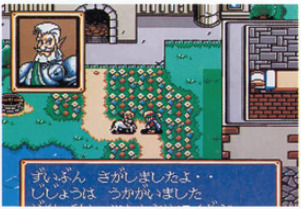
We see more of Guardiana, and the centaur NPC was actually Varios all along, meaning the intro was really different.
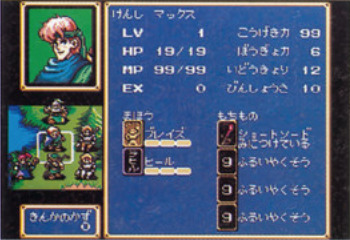

Max and Mae get to smile! Given the story is kinda obvious why this was changed, but I always did find it weird that their artwork had different expressions to begin with.


Plenty of screenshots of a field battle with completely different graphics. More on this later.

Also a different and apparently pretty big shop.
But now for the part that really rocked my socks, a whole beta map:

Here’s the final map so you can compare the geography yourself. This map doesn’t label pretty much any town and instead brings up a bunch of new names for the natural areas.
The Gate of the Ancients, or what I suppose is it, it’s not labelled, sits atop the Mountain of Guidance, which seems to be a single mountain as opposed to the big mass that stretches up to Rindo in the final version. The gate also seems drawn like a little castle, which would explain the indoor bgs shown so far.
Alterone is to the northwest of Guardiana as opposed to the northeast. It is also right next to the Beagle Mountain Mass, which, makes A Lot More Sense with how much we hear it is a mining town. I’ve been wondering where their mines were in the final map. They must have mined too much though, because in the final version this mountain mass is largely gone.
Further to the north is Rindo Harbor, and you, english speaker, might think, “oh yes Rindo that’s the final name” but nope, in the JP version the town’s name is Rindorindo, for some reason, so that’s a difference. A difference that matters to no one.
There’s no river near Rindo, and Manarina and Shade are not labelled, though its concepts seem to be around. Manarina also seems to be surrounded by a lot more forest than in the final version, which might explain its guide book entry.
The forest near Manarina has a name that deserves its own post, Kaien, in katakana so that it is harder to discerning its meaning of course (and intentionally allow double meanings). Possible interpretations are the start of a performance (開演), the opening of a park or garden or banquet (開園 and 開宴), a superb performance (快演), or an eerie yet fascinating performance (怪演). I’d say the last one is the most fitting for Manarina, but localizing it is still a pain in the ass, the english staff dodged a bullet here. Right now most I can think of is Enthralling Forest, but you still miss some charm.
I also have to wonder if Mishaela was conceived as a boss for this place. Puppet performance and all that. She also ends up having a forest stage in Shining Soul.
All the white mass on the north is Pao Plains, no sign of the bridge or the forests of Bustoke, although there is a town in the mountains. Was this a Shining Force without Zylo? Inconceivable. But might confirm something I’ve been suspecting due to my debug mode escapades. In the battle test mode, egress usually takes you to the last church you’re supposed to access in that chapter. Yet for chapter 2 battles, it takes you to Bustoke, which is on Chapter 3. The editor also shows Bustoke as one of the first map in the data, between Rindo and Shade. It is likely that Bustoke was meant for Chapter 2.
In fact the reasoning for going to Shade Abbey is very shaky, you can see in the final map that there’s a lot more mountains between Shade and Bustoke than from Manarina. I guess the point is that guides work there, but in that ase they should work somewhere else. I’m not complaining though since Shade Abbey is one of the most iconic parts of the game.
The Pao Plains are surrounded by the Boho Mountain Range. Boho is short for bohemian, the romanticized view of nomadic/alternative lifestyles, so it’s very fitting for Pao.
Waral was a single island instead of an archipelago, and the ocean between the two sides of Rune is Cypro Ocean, a name that eventually made its way to the guide book. The region in the center of East Rune is Conga Basin, which we’ve also seen in another book, and Dragonia is to the north already. Finally, the Crescent Mountain Range is the bunch of mountains to the east of Runefaust.
Note also the big isolated structure south of Runefaust. Perhaps the Castle of the Ancients has not always been under the ocean. I also see no sign of Prompt, while all other towns are in (except Waral but Waral isn’t even in the final map, it’s tiny). This might explain why Chapter 7 is cursed on debug mode, frequently failing to load an egress point.
All this rambling was just for the map itself. There’s more written about it, I’ll just translate things directly because I’m a bit tired of taking screenshots.
This is the Rune Continent where Shining Force will take place
There’s no comparison between the world of Shining Force with that of Shining in the Darkness, it is far larger. There are mountain ranges, towns, large coasts, and even islands as well. The adventure starts at Guardiana to the south of West Rune, and the you’ll move clockwise to north, and then to the eastern part of continent, shrouded in mystery. That region to the south of East Rune, could it be Runefaust...?
East Rune and West Rune
The two continents and the Cypro Ocean between them are all referred to as the Rune continent, and are far to the east of the land where one day Thornwood, the kingdom where SitD takes place, will be built.
Guardiana, where the journey begins, is on West Rune. West Rune, compared to the eastern side, is more developed, with many countries living in peace and abundance.
In the eastern side, it is said an ancient civilization once lived there, but currently there are no countries other than Runefaust, and a wide spread of steep mountains and eerie forests.
Because of that and Runefaust itself, the people of West Rune regard the east as a dark land full of mystery.
They’ve thankfully chilled a bit on the “light side versus dark side” in the final game, possibly because they needed churches/HQs/shops to welcome the heroes gameplay-wise. I do see something drawn in the map here where Rudo should be, so perhaps other settlements in the east were already in the cards, just not very developed.
The country of Alterone
A neighboring country of Guardiana. It was originally a mining town built to extract rare and magical minerals from the Beagle Mountain Range around it, and then developed into a country. With the minerals excavated, Alterone amassed a lot of money, which was used for its own development. The common citizens began to live in luxury, and even despite other countries. Of course the royal family too has filled the castle with loads of luxury items and art, and the army is small and lacks zeal despite its extravagant equipment. The cultural level of these people with not much history, is not very great. A rising rich country. One could argue it’s a bit like today’s Japan with its excessive liquidity, or maybe not?
oh i am unequipped in so many ways to understand that jab
The country of Guardiana
A country that prides itself in having the deepest history in all of West Rune. It is said this country was built by people who inherited the duty of protecting the “Legacy of the Gods”. Because of that they’ve grow a tradition of respect for the military arts, and the royal family believes in maintaining a humble lifestyle, so the castle has no ornaments or luxurious items. However the long time of peace has weakened these traditions and the people, and they could not defend themselves from Runefaust’s ambitions, being destroyed...
Being a small country, it has little stock of weapons and such, but it is blessed with fertile land and the agricultural production is plentiful. The story of the Shining Force will somehow begin around this country.
Nothing I hadn’t seen in guide books already, but I’m somewhat surprised the worldbuilding was all already there and not refined for the guide books only. I guess it just didn’t find its place in game.
Speaking of that, here’s a long interview with the devs and I don’t have the energy to translate it all. Here’s the summary:
Unsurprisingly, the game’s biggest challenge was data size. Without compression it was around 30MB, around 15x the size of its final ROM, and definitely not fitting a Mega Drive cartridge. The interview only talks about compression but I wouldn’t be surprised if they had to cut things as well.
It’s brought up that they could have solved that problem by making a CD game instead, but they wanted to reach a wider audience.
Lots of comparisons with SitD, how the game was bigger and more complex, requiring more work and graphics and maps and everything basically. Again it is said that the story happen centuries before SitD.
When asked if there's a connection with the SitD, Masaki Wachi (writer for SF and the GBA remake) enthusiastically replies “Yes! Oops, I said it (laughs)”. He then elaborates that there were big clues about it, but that he wouldn’t comment on the connection with Mephisto and the ending of SitD.
Kenji Orimo (director and writer) does add though that if it was meant to be a direct sequel, it would just be called Darkness II. He also mentions seeing more potential in expanding the Shining World from Force than from Darkness.
Yoshitaka Tamaki (character designer, art director) mentions SitD characters having more of a fairy tale vibe, while SF characters were more grounded, with some pretty scary enemies in the late game, with more of a “war spectacle” vibe.
Lots of hyping up the battle animations.
Also hyping up the unique spin on tactical games, where characters and enemies all have their own agility instead of just alternating between an ally and an enemy phase. I don’t know anything about tactical games to comment on this.
December 1991
We get a better scan of Mae’s old portrait :)

Max on the other hand has already changed to his final one. Character description are largely the same as October with a few more tidbits on personalities such as Ken being a super honest boy. Gort is still referred to as Mae’s old servant, Lowe is still listed as dwarf, and no mention of Mae’s tough personality yet. Max’s class is also listed as warrior, but he was mentioned as swordsman on October so I assume it’s just a mistake.
We do get more characters this time though.
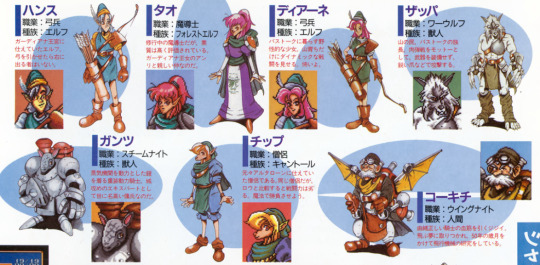
Tao
Class: Mage
Species: Forest Elf
A mage in training, but her talent is huge. Has a close relationship with Anri, the princess of Guardiana.
The forest elf thing is very curious since Hans and Diane are not listed as such. I have seen the term float around for Nigel of Landstalker, but I didn’t play that yet so no comment.
Diane
Class: Archer
Species: Elf
A wild girl who lives in Bustoke. Being raised in the mountains, she’s vigorous in battle. Scary.
Zylo
Class: Werewolf
Species: Beastman
Leader of Bustoke, the mountain nation. Focused in hand-to-hand combat, he does not equip weapons, and instead fights with his sharp claws.
Guntz
Class: Steam Knight
Species: Beastman
A knight of heavy power who wears an armor powered by a steam engine. Well known through the world as a mercenary specialized in castle assaults.
Well, that’s not my chill guy. Seems his personality wasn’t nailed down yet, which surprises me as his artwork very much implies the gentle guy we know now. Worth mentioning though, Guntz does join the team right as you’re going to assault the fort, and the GBA version even elaborates a bit on that invasion by requiring you pick a bomb from Crock, though Guntz isn’t involved in any of that. Perhaps this sequence was intended to be a bit more elaborate from the start.
Khris
Class: Priest
Species: Cantaul
A priest who used to work in Alterone. Despite being both priests, she’s stronger than Lowe in battle. Let’s see who is the best at magic.
Kokichi
Class: Wing Knight
Species: Human
An old gramps from a noble lineage of knights. Entranced by the dream of flying, he spent fifty years researching flying machines.
We then get a bunch of monster art i won’t even try to fit in a screenshot, and more description than they ever got in guide books as far as I’ve seen.
Dwarves
Skilled at close combat due to their strong body, but has low defense. Their lethal axes are menacing.
Dark Priests
Runefaust priests, wearing white masks as per the army’s regulations. Working on an attack with focused magic.
rip dark priests you did not learn blast in time if that’s what they’re implying here
Also, they’re called Dark Priests here, Priests in the final game, and Dark Priests in the english localization. I don’t know why I bother paying attention to that.
Snipers
With superior footwork, they attack from a long range with bows. The double team kind, working as pairs with the Rune Knights.
Puppets
Evil marionettes, it’s unknown if they have consciousness. Part of the Monster Corps, they attack swinging swords.
Except they don’t in the final game. They don’t even have swords in the art either, so I’m unsure if that’s a change or an idea that never made it in.
Hell Pierrot
It seems they are not really pierrot, just disguise as such. Those who are fooled and approach them carelessly end up hurt.
That’s the final JP name for the Dire Clown as well.
Gargoyles
They are statues, but had temporary life breathed into them by magic. Seems not all of them turned into flesh, some parts remain stone.
Cerberos
Guard dogs of hell into a deep sleep in the caves under Alterone. Trained by the Runefaust army.
Worms
Giant mutant earthworms dozens of meters long. Don’t have any senses other than touch.
Dullahans
Headless ghost knights who used to be Rune Knights. No comparison between their power though.
And now a special boy that does get to be screenshotted:

Mimics
Transform immediately as you open them thinking it’s a chest. Their lids grow sharp fangs, and they sprout legs to move.
It’s worth noting that while these guys didn’t make it to any classic game, SF2 does have a mechanic of monsters spawning from chests, we just don’t get to see because the search in battle option was removed in the english version.
To finish the parade of weird creatures, Yogurt is here.

What is this Yogurt creature, after all?
Yogurt, a mysterious characters that shows up around Guardiana and toys with the enemies. No clue if he’s an enemy or an ally, but he certainly has a likeable vibe, you could even call him cute. He’s not docile enough to be raised as a pet, and seems prone to quick mood swings. Does a lot of weird things as he pops up in the adventure. You could say he’s kind of a versatile performer.
Yogurt’s Data
He’s 80 cm tall, weights 10 kg, walks on two feet, while the front paws have atrophied and become small. His main food seems to be berries, but he’s omnivorous. From what’s been observed, he can swim, is fast and has strong jumps. It’s unknown when he started wearing the helmet on his head. No one has seen him take it off either.
Insides:
Tail - Uses it to balance while walking in two feet.
Feet - Way better for jumping than for walking.
Head - On par with humans. Seems to be very intelligent.
Hands - Cannot use tools
Belly - Quite fat but he’s still agile.
There are also doodles of his secret appearances which I’m not gonna translate now. They’re very much just describing his antics.


January 1992
Pink haired Simone appears. Sadly there’s no dialogue screenshots.
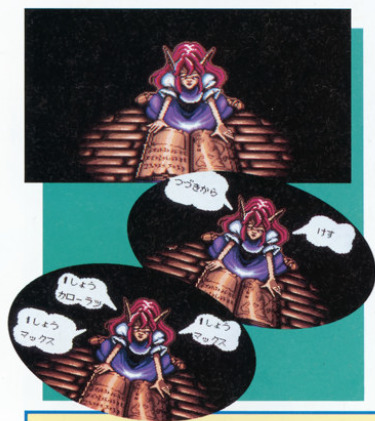
Guardiana is already pretty much the final version, only the entrance still seems unfinished, some NPCs are different.


Remember that field battle with different graphics? There’s more of it here, including the map.


It’s horrifyingly large.

Finally, there’s some talk of critical hits being capable of special effects like one-hit KO, but it’s very vague so it might be the magazine staff not knowing this was attached to a specific weapon.
February 1992
Pink Simone is still around, and so are unfinished weapon animations and the old knight battle sprites. Max still shows up with zero MP. Guardiana and the starting maps seems mostly finished with a couple odd spots.


Guardiana castle is full of chickens, and has a gate.

The king’s room has a couple more flags in it.

The Gate of the Ancients now looks like the final version, though battle screenshots still show the indoor background. The starting team is also the final one, with Mae and Gort no longer there.
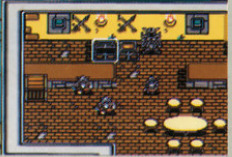
The Alterone battle shows enemies inside the shops.

The article ends with a recipe for yogurt.
March 1992
The game is released, and I too am released from this long ass post. From here on, every article, ad and official material I’ve seen uses only screenshots from the final version of the game. If that sounds obvious to you, wait for the SF2 post.
Update: ??? 1992
Joke’s on me, I was not free from the post. I found some old footage, sadly i don’t know which date it is from, but it shouldn’t be too early in production. Simone already has brown hair, the Gate of the Ancients is already outdoors.
There are still things to note though. Simone still talks of the king of Guardiana in her intro as opposed to the final one. The intro to Chapter 1 is a placeholder text.
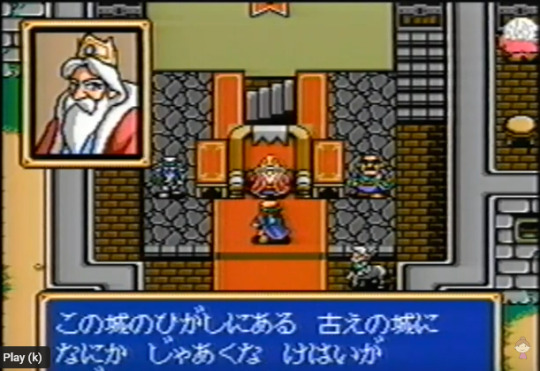
Anri’s dad does not have a unique portrait and uses the default king one. Also, the castle still do not have centaur knights, even though their sprite already exists. In the place are not chickens though, and instead some weird placeholders you can see at the top right corner here.
Unlike every other battle scene in this post, the final sword sprites are in, but their animation for Max is still unfinished. Also, having footage we can hear some audio, and while Simone’s theme and the field map theme are in, the town and battle scenes use placeholders from SitD
More importantly,
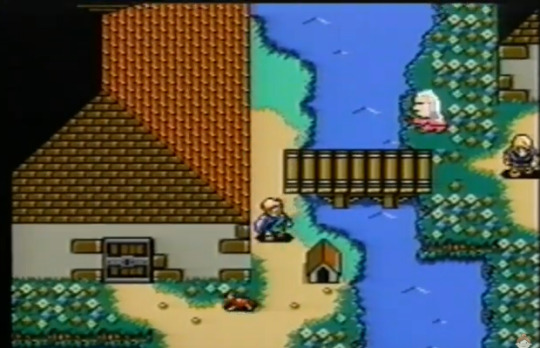
cat.

Their sprite isn’t exactly the same as the unused ones in the ROM though, as those have the tail up like a properly happy cat. This means these sprites still got further polish before being ultimately scrapped anyway :(
#shining force#shining series#sf yogurt#sf max#sf mae#sf gort#sf simone#sf guntz#long post#reeeeeeally long. i am dying#second time trying to update this because tumblr disappeared the first one somehow. if it goes wrong i'm gonna start biting
14 notes
·
View notes
Photo


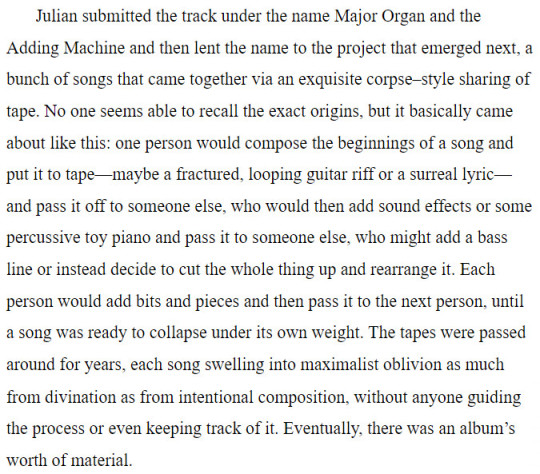
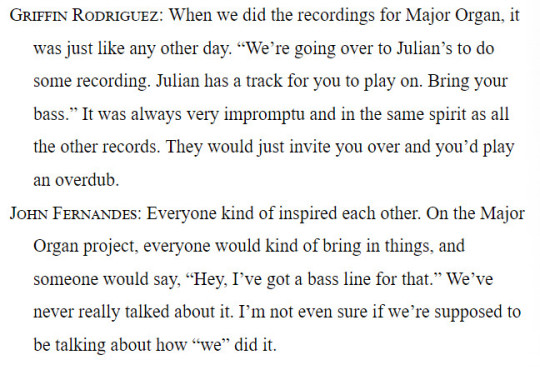


About “Major Organ and the Adding Machine” album
(fragments from 'Endless Endless' by Adam Clair, 2022)
transcript:
One of the zanier things that grew out of this period was Major Organ and the Adding Machine. The entity produced one self-titled album, though it’s not entirely clear who that self is. It was created with no intention to release the album to the public, though that happened long after it was finished. The album is also not the most highly regarded in the E6 catalog. It’s easily one of the weirdest, though, and given how it came together, it serves as a remarkable document of the time period and community, like some kind of Dadaist Polaroid. The stream of unselfconscious is evidence that even without commercial ambitions of any kind, folks were still doing their thing, trying to entertain themselves and one another.
The project began a cover of “What a Wonderful World” that Julian, Jeff, and Jill Carnes recorded together for a Kindercore compilation of Christmas music released in 1997. The Louis Armstrong original is a song most people have heard so many times that it’s basically white noise, but the Elephant 6 rendition has its own feel. Of the trio’s contributions to the song, Jill’s vocal melody hews closest to the familiar, but her creaky timbre weaves in and out of Julian’s ethereal saw like a frog clambering through a thicket of swaying cattails. Jeff’s verse in the middle is modulated just to the point of peculiarity, and a haunting tape loop from his homemade sound effects library undergirds the entirety of the two-minute track.
Julian submitted the track under the name Major Organ and the Adding Machine and then lent the name to the project that emerged next, a bunch of songs that came together via an exquisite corpse–style sharing of tape. No one seems able to recall the exact origins, but it basically came about like this: one person would compose the beginnings of a song and put it to tape—maybe a fractured, looping guitar riff or a surreal lyric—and pass it off to someone else, who would then add sound effects or some percussive toy piano and pass it to someone else, who might add a bass line or instead decide to cut the whole thing up and rearrange it. Each person would add bits and pieces and then pass it to the next person, until a song was ready to collapse under its own weight. The tapes were passed around for years, each song swelling into maximalist oblivion as much from divination as from intentional composition, without anyone guiding the process or even keeping track of it. Eventually, there was an album’s worth of material.
[...]
Griffin Rodriguez: When we did the recordings for Major Organ, it was just like any other day. “We’re going over to Julian’s to do some recording. Julian has a track for you to play on. Bring your bass.” It was always very impromptu and in the same spirit as all the other records. They would just invite you over and you’d play an overdub.
John Fernandes: Everyone kind of inspired each other. On the Major Organ project, everyone would kind of bring in things, and someone would say, “Hey, I’ve got a bass line for that.” We’ve never really talked about it. I’m not even sure if we’re supposed to be talking about how “we” did it.
Kevin Barnes: In the best way, it was a collaborative project. Everybody seemed to be contributing equally and making everything better. It was never getting worse because somebody laid some stupid tracks on it. It was like, “Whoa, this song is so much cooler now, and it was already cool.” I wrote that song “Madam Truffle.” I don’t remember who got it, but they sped it up really fast, and there’s this extra cool stuff Eric added.
Julian Koster: But we weren’t doing it to put it out. That was the thing. It entertained us to no end. It made us all laugh when we listened to it. It was just so funny and weird and fun. We all loved the Boredoms and Faust and Stockhausen.
[...]
Most of the recording happened in 1998 or thereabouts, and the album was released to the public in 2001. The finished product is every bit as eclectic and bizarre as anything else in the Elephant 6 catalog, and even more opaque. [...] Absolutely nothing had to be distilled into something accessible, because no one expected it to have an audience that wasn’t in on the joke. No one expected it to have an audience at all, beyond the people who made it. If the spirit of their weekly potlucks could be transposed into a record, it would be Major Organ and the Adding Machine.
4 notes
·
View notes
Text
Incredipony important Homestuck lore dump
“We know that Dirk has a genuine fondness towards Rainbow Dash. What are your thoughts on Friendship is Magic? Do you enjoy the show, or did you only include the cyan pegasus for the sake of humor?”
I’ve seen like one episode. It’s nicely done, but it’s a damn show for kids. I do some silly shit with my spare time but I am not a child. Some people think this makes Dirk a “brony.” I think it’s more that he really does watch it and evaluate it for whatever studious purposes he has, but just happens to like that one pony unironically. A brony does not this a dude make.
Sure, Hussie, sure. (x)
Anyway Dirk G1 Firefly stan -- and I can prove that G1 Firefly is intrinsic to Homestuck, and that Dirk is right to admire her, and that Hussie is definitely wrong about his own comic.
Firefly's Dirk connection/Firefly as symbolising the entirety of Homestuck
This is Firefly. She appears only in the MLP G1 pilot. Fittingly for a pilot episode, she’s a daredevil flyer.

Firefly’s function in the story is, motivated by nothing more than her hope, to be the first to fly “over the rainbow” to the fabled human world and bring back a human champion to help the ponies. In other words, she’s the first to breach the barrier between worlds and essentially the prime mover of all the G1 plot.
Firefly’s signature move, the thing she’s attempting in that gif (and an equivalent of G4 Dash's sonic rainboom), is called the "double inside-out loop".
HOLD ON. A DOUBLE “INSIDE-OUT LOOP”? SOUND FUCKING FAMILIAR???

My thesis:

Most Important Horse
Firefly IS the Möbius double reacharound, the breacher of barriers, which is the same as the joiner of the two worlds (sessions).
As such, and with her heroism presented as a less corrupted version of AR and Dirk’s badass plan in Unite Synchronise, Firefly is an absolutely indisputable -- and, I’d argue, a deliberate -- homage to Homestuck.
I mean, Homestuck features a literal firefly. And that firefly is not, as we all thought, a Joss Whedon reference.
The pony Firefly, pink* and blue, combined with the clouds that in Homestuck generally symbolise the Light of prophecy and/or the power of Hope, forms the colours of the trans flag. Joss Whedon who? Serenity, the transfeminine symbol, is G1 Firefly. With the addition of the rainbow connection, Firefly as an obvious queer symbol gels too well with Homestuck’s deeply queer themes to be a coincidence.
[*She appears purple in some grabs, and while it’s tempting to make something out of that as positioning her as equinedistant between red and blue, that’s just the sucky 80s cartoon colour grading. The toys make it clear she’s intended to be pink. (x)]
Basically:
Hussie doesn’t know what he’s talking about. Firefly, in many senses, IS Homestuck.
And Firefly’s G4 reincarnation courtesy of Lauren Faust (Faustus = LE/demiurge symbolism? Look into), because Hasbro had lost the rights to Firefly’s original name and design, is Rainbow Dash. (x)

Case closed. Moving on.
A note about the villain of the G1 pilot:
Tirac is an obvious LE stand-in but he’s rather bland, though his Gnostic themes of the (heterosexual) corruption of the pure (queer) rainbow world are still present. There’s not much to say about G1 Tirac. He’s a fairly forgettable monster of the week, unlike his inspiration; though he’s a LE homage, he’s not a very well-executed one.

It’s worth noting that he’s more fleshed out in G4 as Lord Tirek*, but G4 doesn’t strictly adhere to Homestuck canon due to being canon within Homestuck, so there’s not much there except his theme of age being an obvious callout to Time powers, and his use of a power similar to Dirk’s (LE being Dirk through the linking factor of Lil Cal -- who is cleverly presented in G1 as the baby ponies en masse, but I don’t have time to get into that -- and Doc Scratch).
[*Yes, the spelling changed.]

G4 Tirek’s apparent age and physical fitness fluctuate in both directions, through several forms, in accordance with his pwr lvl. This is of course a clear allusion to Caliborn, in both the general Time theme and, in specific, Caliborn’s non-linear appearances within Homestuck.
It’s clear they wanted to take Tirek’s redesigned G4 form in a different direction, but some influence still seeped in. It’s no coincidence that he’s a Timey-wimey red colour, nor that his powered-up form has a distinctly musclebeast flavour (ARquius, again with Doc Scratch as the linking factor).

(Seen here with Cozy Glow, another conspicuously trans-coloured pony, as if we needed more evidence.)
(I could write another post on Grogar’s Hope symbolism centred on his bell, but this shitpost has already got way too in-depth.) (Anyway, Egg Friend, this one’s all for you. Happy Homestuck lore-hunting.)
(YES, THIS IS A SHITPOST)
#friends#homestuck#my little pony#caliborn#lord english#mlp firefly#rainbow dash#lord tirek#shitpost#trolling
1 note
·
View note
Note
Which books or poems do you think Voldemort and Bellatrix would rather like?
Now I'm forced to bestow upon them some of my own favorites, anon. The three of us share tastes, okay?
Poetry-wise, I think they would both love Invictus by Henley, Paradise Lost by Milton, The Divine Comedy by Dante, Marlowe's Faustus, the entirety of Shakespeare (in particular Macbeth, both identifying respectively with the two protagonists, Bella openly adoring Lady Macbeth and Vold tormented in his most intimate musings, just as for Hamlet - Bella would also really like Antony and Cleopatra), most of Keat's and Byron's lyrics (especially Ode to a Grecian Urn and Cain and Lucifer in the Abyss of Space for Vold / La Belle Dame Sans Merci and Love will find a way through paths where wolves fear to prey for Bella), Verrà la Morte e avrà i tuoi occhi by Pavese, old epics and mythology (Vold would love Homer and Euripides and I like to think he studied the myth of Dionysus' "death" and rebirth at length, since obviously JKR stole his own downfall and resurrection from there, the two facts being basically identical - while Bella would take Medea, Iphigenia in Aulis, the Amazons and The Bacchae as role models). Also I can see Bella loving Because I could not stop for Death by Emily Dickinson and Do not stand by my grave and weep by Frye.
As far as general literature is concerned, I can see both of them reading extensively war/philosophy works of any time and place (Vold introduced Bella to them when she was young) such as Il Principe by Machiavelli, The Art of War by Sun Tzu and Onassandros and Tactica by Arrian, but even general philosophy particularly strikes me as something Vold would be into. Novels-wise, I can see them both loving Wuthering Heights by Emily Brontë (Bella thinking she introduced him to the book, while I imagine him reading it during summer-break at the orphanage, both loving and hating it), The Modern Prometheus by Mary Shelley, The Count of Monte Cristo by Dumas, Stories of Sherlock Holmes by Doyle, the entirety of Poe's and Lovecraft's works, The Picture of Dorian Gray and Salomè by Wilde, Goethe’s Faust, Lord of the Flies by Golding, The Letters of Aberlard and Héloïse (Bella is very fond of them), The Birth of Tragedy by Nietzsche, anything Bataille ever wrote, The Master and Margarita by Bulgakov, The Arthurian Cycle, The Ring Cycle by Wagner (yes, they both love Wagner) and Beasts, Men and Gods by Ossendowski.
#bellamort#hope it helps lol#anon#asks/replies#one and one thousand stories lis told#books#lit#my favorite books#greek myhtology#mythology#classicism
23 notes
·
View notes
Note
Hi Kay!
I just wanted to take a moment and say how deeply moving (and overall comforting) I find your writing to be! I've gone through almost the entirety of your masterlist twice in the past month alone and have found myself returning more often to the pieces of literature/poems your reference sometimes. (Especially that one poem by Benedict Smith! I've read a few more by him because of you and they're just wonderfully lovely 💛 so I'm eternally thankful to you for including it.)
I may be wrong in assuming, but I believe you may have studied/are currently studying a degree involving literature. I hope this isn't too foreward of me but I was wandering if you have any other works of literature that you'd recommend? (I'd love to read anything you recommend from poems to plays 💛) I'm slightly embaressed to say but the works I've read are quite limited to a highschool level and since I'm currently studying Pharmacy, there are very few people who can recommend me such moving works. :)
I also feel like I should apologise for writing such a large ask, so please accept this apology as well hehe 💕🥺
Sincerely,
Bek 🌻
Hey there Bek 💚💕✨
First of all... I'm incredibly sorry for how long it took me to reply to this ask, I know you sent it weeks ago and I'm honestly just ashamed of myself for only replying now! I've been taking a bit of a Tumblr break again, or rather a break from literally everything, and I guess not having written anything in a while made me feel guilty whenever I opened Tumblr, so... All I can say for myself really is that I'm sorry you had to wait so long! Again, I never ever ignore anyone, I promise! It just sometimes takes a while for me to reply 😅🙈
Now, I'm so happy to hear that you've been enjoying my writing! 🥺🥰 Hearing that it's comforting and inspiring to you is honestly such a relief and indeed does make me happy more than I can say 💚 It's so cool that you're checking up on all the references I make aaahhh 🥺🥺🥺 I love it 😁 You're always more than welcome, love! I don't think I could stop including references to literature, culture, history and the science around it even if I tried 😅☺️
And yeah, I did study classics and newer literature as a minor for my undergrad degree 😄 But tbh I still work with literally a lot even now (I'm in grad school for media and cultural studies) even though it's technically not something I've been properly taught ☺️ I'm just a nerd who likes to learn on her own, and with media and culture you can pretty much delve into almost anything you want 😂😅🤷🏻♀️
Now, it's not forward at all to ask me for literature recommendations! 😁😃 I truly love recommending stuff!!! I have a few up my sleeve, even though you've probably heard of a few already, for obvious reasons: A lot of what I truly enjoyed reading was something Tom Hiddleston has worked on in one way or another! It's truly a magnificent guideline for picking new literature... Just look up the literary origins of his films/shows/plays and you will be in for quality literature most of the time! I don't think I've ever mentioned it on here, but me reading High-Rise (JG Ballard) because I heard Tom would be partaking in the film adaptation was actually what sparked my love and passion for literature!!! Yep, it's that good. Now on to the recommendations though 😁(This... got rather long):
Plays
Anything by Harold Pinter really, but for obvious reasons you'll find a lot of additionally fun stuff for Betrayal, which is lovely and truly funny if you're in on the kind of humour btw
Medea by Euripides (a classic, but I love it nonetheless... You can find translations in almost every language) ((and pls stay away from Seneca's Medea, because ugh... Euripides is far better AND the og story, as much as anyone can say that for Greek mythology)
La Bohème by Puccini (I know, this is technically an opera, but if you read the libretto it's honestly just like a play... And if you're up for it, the og story is in prose and written by Henri Murger... It's better than the opera, but oftentimes more difficult to find) ((this one is hilarious and basically explains an entire cultural subgroup in the 19th century)
Faust by Goethe (many people hate it, but I LOVE this one!!! It's also been translated into any and every language, and it's so interesting philosophically!!! It's also referenced SO freaking often literally everywhere, and the operas and ballets based on it are always my fave) ((there's technically Faust I and Faust II, but you're good to go just reading the first one)
Anything by Shakespeare, obviously... Though I do love me my Hamlet like every other literature enthusiast (Yes, I can do that one famous soliloquy in act 3 scene 1 by heart as well...)
Poetry
Again, anything Shakespeare for the win, but I LOVE the sonnets and keep a copy of them with me most of the time (Yes, I own multiple copies of the sonnets...) ((My faves are 116 and 91, but there's always so much truth to be found in there!!!))
A lot of the stuff William Blake wrote is amazing, though you have to pick carefully with him if certain religious motives aren't your thing... I love The Tyger, which is an individual poem, and the collection of works called Tyger, Tyger which does have many good ones and a few ones that are a little more on the mediocre side
Do not go gentle into that good night by Dylan Thomas (I know this one by heart as well... It's beautiful, and there's a version of Hiddleston reading it on YouTube, which gives you even more goosebumps than the poem does anyway)
Invictus by William Ernest Henley (same for this one, also read by the one and only) ((I love to read this when I'm feeling down or powerless))
The Love Song of J. Alfred Prufrock by T. S. Eliot (This is another wow piece with many quotable lines and truths... I love it a lot and keep coming back to it! It's also a great example of how literary modernism tried to condense the complexity and passing of time and history into a single frame that had to be intrinsically poetical in nature... As in, this poem could've been a short story in any other period, but modernists loved to make everything a poem so here you go)
Der Zauberlehrling by Goethe (This one sucks in all English translations I’ve found, poetically speaking, but in German it’s such a fun piece! If you’ve ever seen the Disney ‘The Sorcerer’s Apprentice’ with Mickey Mouse or listened to the orchestral piece by Paul Dukas, then this poem proves very useful in truly understanding either! But again, the English translation should only be taken for informational value... The German one is also worded hilariously)
Prose
Short edited by Alan Ziegler (This is a collection of short prose forms that honestly is a must for me... I love this book to pieces and have had it for years now! It’s an international anthology, so you’ll find more and less famous authors from all around the world represented with short stories, prose poems, short essays and just curious and interesting snippets of writing! I draw a lot of inspiration from this book)
High-Rise by JG Ballard (As mentioned above, I owe this book part of my personality... I don’t think I would be the same person without having read it. It’s not necessarily full of wisdom, but if you’re interested in a different kind of portrayal of the human condition, then this is the read you need to take a look at)
The City of Dreaming Books by Walter Moers (This is another piece that changed my perception of literature, even though this is a more ordinary and ‘fun’-value read... It’s one of my favourite books and it’s endlessly entertaining! So if the classics are a bit heavy for you, this one is perfect for casual readers as well! Its value really does lie more in the realisation of how fun literature can be, and the freedom you have as an author... So really, I could recommend everything by Moers, his style is amazing both in the German original and in the English translation. Yes, I’ve read both.)
Good Omens by Neil Gaiman and Terry Pratchett (This is comedic gold, stylistic gold and generally a bloody perfect book. Also a ‘fun’-value read, but it also does a magnificent job at showing you what you can do with literature, and how well-developed characters are supposed to be written)
The Penguin Book of the Undead (Penguin Classics) edited by Scott G. Bruce (This book is basically an education on fifteen hundred years of supernatural encounters and how culture wrote, used and perceived them. You get introductory texts for different periods and social groups, explaining how and why ghost stories were written and used, followed by passages of the prime source texts (eg. ancient necromancy shown on The Odyssey). Really, this book is just for cultural history nerds)
The Earthquake in Chile by Kleist (This isn’t necessarily one of my faves, but it has helped me understand what studying literature and culture can do for you. In case anyone remembers my insistence in Wicked Game that you gotta know what a pomegranate symbolises... this novella is such an instance where this knowledge would prove useful. Generally, it gives many opportunities to think about privilege and circumstance)
The Symposium by Plato (You’ll probably not want to read the entire collection of speeches tbh... But the concepts introduced mainly here and in some of Plato’s other work are well worth looking into! For example, the ‘double being’ introduces a concept that in modern fiction is called soulmates... Just sayin’)
31 notes
·
View notes
Photo

The following article was written by Faust in October 2000 and published on the website of the British record label DarkWhispers (darkwhispers.co.uk). Both the label and the website are now closed, but parts of the site can still be found (as of may 2021) through Wayback Machine here.
Since I consider this to be a rare document, I thought it would be a good thing to make it available here in its entirety, that is, even the parts that are not strictly about Euronymous. I think what Faust wrote about Dead deserves to be known as well.
. . . . . . . . . . . . . . . . . . . . . . . . . . . . . . . . . . . .
Everyone Knows the deceased Dead and Euronymous; either by name, reputation or activities. These people are by many claimed to be the originators of what has turned into a vivid and extensive Black Metal Underground Movement; an honor they serve through the fact that their lives and also post-existence ensured to gather the complexities of the once so weak and tiny scene, elaborating the basic principles and put it to practice.
These two persons are by many also claimed to be the real Mayhem, what constituted Mayhem in effect. Euronymous had from the beginning engendered and ensured Mayhem's music and riffing, from the chaotic and crushing music that could be found in their Deathcrush-era to the atmospheric yet intensely brutal sonic metal towards their De Mysteriis Dom Sathanas-era.
Dead, with his haunting vocals, made the listener imagine an audio-trip to the lost castles of Transylvania while at the same time giving the impression of just having risen from the grave. Dead lived up to his pseudonym - and he should live even more up to it than anyone would like to imagine.
The last time I ever met Euronymous was in his flat in Toyen, Oslo, in early June 1993. I was at that time playing in Emperor and we were heading towards a mini-tour in England with Cradle of Filth. Euronymous had just closed down his shop, Helvete, as a result from massive media-pressure because of the criminal activities that rose to unexpected heights in the Norwegian Black Metal scene. The plan was to open the shop again in a more visited area of the city and therefore to ensure a bigger economical income. This night I visited Euronymous one last time before going to England and discussed a few matters with him. That was the last time I ever saw him alive.
Emperor returned from England about two weeks later; exhausted and sleepy but with a little broader horizon and richer experiences. I never met up with Euronymous again since I shortly lived at my father's in the north-east of Norway, but I went to Oslo the 10th of August to visit him. The shock was enormous when I was in the middle of the police-investigation and was brought in for interrogation. I couldn't imagine that anyone had killed Euronymous. I wont dwell with the details concerning his death, the people behind it or anything. It has nothing to do with this article. But it's clear that from that point the scene had lost one of his main participants, and in my eyes, the scene would never be the same again. Unfortunately.
Dead died in April 1991, then fully completing and realizing his long-time band pseudonym. I appreciate very much that I got to get known with Dead the time he spent in Norway. He was indeed a strange personality. Posterior to his death; all kinds of myths have been made about him; he was really the personification of an evil madman, according to many. Well then let myths be myths and focus rather on reality as it appear in broad daylight. Dead was a nice man and Dead was a good man (a description many might find "blasphemous" but it still doesn't hide the fact that Dead was a good man). He had his own little view of life, which was constituted by Transylvania, vultures, bats, grim trees (he often went into the woods to paint "grim trees"), graves and non-synthized Black Metal. In despite of his obsession, he was harmless and wanted to leave alone and be left alone.
There's no need to speculate about his death. Sure I have heard the rumors like everyone else, but forget them, Dead died by his own hands. There's neither no need to speculate in why he did it. He is gone and I think his death was the first massive setback for the scene, which was in its early, juvenile stage. This seriously showed us that life is hard and that things might happen independent of what we want.
Nowadays, there is a discussion on various Black Metal chat-rooms, letter-section in Metal-magazines and through the regular forums for dialogues if Mayhem should continue or not. As for me, having known all but one of all the members of Mayhem through history, I choose not to view it that way, but rather look on Mayhem as a complex entity - a driving force - that is inevitable and inexorable, a force that is here to still push the limits that exists in music. This way, Mayhem will never die, a fact that both Euronymous and Dead lived and died in their own days.
#euronymous#oystein aarseth#dead#pelle ohlin#mayhem#black metal#faust#emperor#pelle committed suicide#if you believe oystein killed him you need psychiatric help#let me be clear#i don't have patience for idiots and conspiracy theories
61 notes
·
View notes
Text
The Magnum Opus: Amy’s Origins
So I don’t think I posted here about it but I finished uploading Amy’s first story! The Magnum Opus is now fully posted and ready to read in its entirety! Here’s the summary (if clicking the link is too much work):
Alchemy’s most basic law is that of Equivalent Exchange. In order to gain something, something of equal value must be given. Even if one does not understand this fundamental law, the Universe enforces this indiscriminately.
Amelia Faust learned this in one of the worst ways possible.
Set over a decade after the Promised Day.
OoOOoo very mysterious, am I right?
I had a lot of fun writing this story. So much so that I already have a bunch of side stories and another multi-chapter fic in the works! So if you’re curious about Amelia Faust and her story, I have quite a bit of content coming. :)
So please if you’re looking for a new FMA fic, consider reading this one? If you like it (or don’t and still read it), consider commenting or dropping an ask here? No pressure, idk how to interact with fandom still tbh...
#Fullmetal Alchemist#fullmetal alchemist brotherhood#FMA#fma: brotherhood#fma:b#FMA OC#OC Amy#AO3 fanfic#fanfic#fanfic link#edward elric#alphonse elric#winry rockbell#FMA ED#fma alphonse#writing#ao3#ao3 works#fma fanfic#fma fanfiction#fma fandom
3 notes
·
View notes
Text
I have a lot to say and not enough time to say it. It hurts, but ya’ll know what this is about so if you want my full fandom retrospective opinion thing guys, here.
I’ve been following Vivienne’s art and career since I found her on dA in 2009. I’ve basically grown up with her and have a wide range of opinions up and down her collective work. I must stress that I do not know her as a person and no matter how critical I get in my personal time if I somehow met her in real life or converse with her online again (like, back in the day we went back and forth. She was pretty nice to me), I’d be humble and congratulate her for her success.
Critique does not, EVER equate to attacking people.
But
the reason I don’t call myself a VivziePopVivzmind-fan is the exact same as to why I don’t like the proud use of ‘anti’. Let me try and explain -
The vast majority of Viv fans are just that: fans. Viv’s one of their favorite artists and they’re happy for her and obviously defensive when some mouth breather pops into their fan discussion calling her and all of them trash. Quite a lot of the Hazbin fans I know in my circle of friends are all pretty accepting and agree on the problematic notions and implications of her work.
HOWEVER, there’s a vocal minority in the VivziePop fandom that were and still are toxic. Their specific interest in Viv back in the day was toxic...and now that she’s moved on into a successful career I doubt they’ve gone away, considering the things I’ve heard. These people - they’d flood Viv’s comments sections and stuff with messages like they were talking to her when they weren’t and they’d unironically call her a god in a way that feels like gaslighting, ex: “I’ll NEVER be as good as you Viv! My art is just sooooo unpopular oh god you are incredible no one will ever like you as much as meeeee”. It made me uncomfortable. It made me not want to be around her because these people took Viv’s role in their lives so seriously and their demand for her attention...it struck a nerve.
These same fans have been around long enough to see actual shitlords - the likes of Kiwifarms and tapatalk wikis - come in and actually harass Viv. Viv’s been sent revenge porn by sick freaks who think they’re funny and believe she deserves it. No. In my non-name fan bystander opinion, Viv’s got some shit to work on, but no one deserves raperevenge porn. EVER. It was genuinely bad and yes Viv and her base have every reason to NOT TRUST these communities. Unfortunately, when these incidents happened, these particular fans took it upon themselves to gatekeep the fandom and act like Viv’s unofficial guard against any kind of decenting opinion of her, all without her say so.
((to the critics who will be all “but Viv or Faust said THIS to their fans-”, like I said, Viv’s far from perfect but regardless of how much she prolly wanted people to side with her I’m gonna guess that she didn’t want people sending transphobic death threats to DollCreep. Again, and this is coming from a bystander here, I have a feeling Viv knows about some of the toxicity but doesn’t know how/want to address it - which is a conversation all it’s own.))
This particular breed of VivziePop “fan” holds so much toxicity in her fandom(s). They aren’t the only cause, but they’re there. They feel entitled to her attention and her approval. They creep me out. Having spoken to other much-less critical admitted fans of Viv around me, these fans appear to creep everyone else out and put the rest of the fandom on edge. They’re gatekeepers. They’re creeps. Like the bronies and SU fans of yestertodayyears, they know harassment exists and that people have crossed the line - so they think any means is necessary to prevent that is automatically good. I could pile together all the incidents and folks who’ve had bad runs ins with this aftershock of Viv-obsession, but I do have a life of my own and this post is already stupid long so I’ll just list out the biggest examples and provide receipts when asked.
Critical blogs have gotten RAPE and death threats because they don’t like Viv’s art. HonestZoophobiaCriticisms, a blog I interracted with back in the day, def got one. Now Viv’s opinion of crit-blogs is that they’re “bad takes” but I can assure you she doesn’t want that shit being said on her behalf.
I’ve seen young artists get blacklisted from sites and forums cause they so much as post a redesign. Viv and co get told through the grapevine that someone’s making hatespeech and so preemptively block said person (prolly cause they’re in the middle of WORKING and can’t deal right now) only to find out after the fact that no, it was just a kid drawing their version of her characters. There’s serious miscommunication issues within the fandom about who’s ‘good’ or ‘bad’ and once you get the actual staff involved in this game of telephone you’re begging for trouble. The problem acknowledged, however, it’s souly from the “Viv never did anything wrong camp”. No word is said about how ugly the fandom is under the surface it’s all one type of person’s fault and not complicated’. Blah
I’ve only ever had ONE obsessive ‘fan’ who’d stalk me, mock me, and then redraw my art just to get attention from me. That shit fucked with my head. As a follower hundreds of miles away from Viv who’s agreed/disagreed with her through the years - I absolutely believe her when she says she hates ‘creeps’ and that she doesn’t want anyone in her fandom spreading hate on her behalf. It’s the one thing about her I’m POSITIVELY sure of. Whether she believes that said underlying harassment exists and/or is even a problem within her fandoms is anyone’s guess. That’s not what I’m here for. I’m here to write stupid blog entries like this, talk about fandoms and media and how they and the real world affect one another, and rb fan art I like. I’m cautiously optimistic fan with a side of salt.
Mixed opinions and critique within a fandom CAN and SHOULD exist. Hazbin Hotel has been greenlit by a studio! It has a product line of merchandise you buy. Helluva Boss is getting eight more episodes this coming year (yeeee:3yeeee). Two of Viv’s properties are now products. Nothing is immune from critique. And in critique you will find a lot of people who are not ‘nice’. Critique or analysis doesn’t have to be nice. There will be, in Viv’s words’ ‘bad takes’ on her writing. Maybe they will be actual CinemaSins-styled bad takes or maybe Viv is just mad that people don’t love and feel inspired by her characters the way she wants them to - it’s a fact she’s going to have to get used to.
((TBH, I’m pretty sure she’s already realized that criticism of all types need to exist. It’s just that, again, her and the SpindleHorse staff are kind of overwhelmed by all matter of takes and opinions coming their way they kinda can’t deal weeding out the fair ones from the assholes, so she lumps them all together.))
Shitposters, ironic fans, unironic fans, critical fans, just critics of Hazbin and Helluva CAN and WILL exist. They should exist and not feel threatened by the megafandom. There are people out there who are one step further and rightfully bothered by Hazbin/Helluva’s use of incorrect symbols, portrayal of certain topics, and the response by creators. These people have strong opinions and are actually disgusted by Viv. They deserve to exist too and should not be vilified because, like me, they’re commentary doesn’t consist of anything personal towards the people at Spindlehorse or the fans of her works. They can rant, they can be professional, they can be petty and they can be fair. But they will exist. You have to deal with it.
I am an ADD/OCD ridden autistic woman with serious anxiety issues who has no one to talk to half the time and so only HAS my fandom to communicate with. But that’s just it - it’s a fandom. A community. You have to learn to not think souly of yourself and of others in a community. A fandom doesn’t exist just for you or any one person. You have the right to be angry and defend or be offended. And it’s in the spirit of that that I ask, prrraaaaaay even, that I please
NOT BE CALLED AN “ANTI-ANTI” for not liking the moniker?!
I DON’T TO BE AN “ANTI”. Not ironically, not unironically. ‘Anti’ should be for politics and shit like pedophiles, necrophiles, nazis, serial killer stans, Trump, racists, antisemites, terfs, animal abusers, rapists, and antivaxxers. Anti should only come into critical media analysis when these ethical issues follow suit IN TO fandom discussion. ((EX: Anime and MLP proudly waving their cp and non-con into the public eye; Hazbin appropriating cultural symbols which are not satanic; Basically anything that concerns John K or Butch Hartman.))
If your DNI list unironically consists of the entirety of one fandom: CONGLATURATIONS! You have done the exact same thing these particular creepy Viv fans have done: monopolize the conversation. And yes, people I’m referring to, IT’S STILL A PROBLEM EVEN IF YOU’RE FIGHTING RACISM/SEXISM/HOMOTRANSPHOBIA.
There are hundreds of Vivziefans who ARE more critical, accepting of faults, interested in discussion and especially rewrite and redesign stuff who would LOVE to engage with you and give you a follow. There’s hundreds of people who no doubt agree with you!
But the thing I’ve seen these very proud AntiHazbinVivzieHelluvaWhatever blogs do is lash out at fans for continuing to like Viv and consume Viv’s art in a healthy way. What the actual fuck is your problem?
I get it. Say a crazy Hazbin fan gets on your case for even SUGGESTING Viv could be homophobic ((”SHE’SBIANDWORKSWITHGAYPPLblahablahblah”)). They get in your face, make some callouts, try to rile up support against you, leave disgusting harassment throughout your social media? Absolutely ban worthy. After that it’s perfectly understandable why you don’t want to engage with anything HHHBZPVivzierelated because you’re so fucking tired of being labeled an abuser or “just jealous” for having an opinion on a show you don’t like. I’m with you!
But,
A fan agrees that something in the canon is bad or that Viv did something they don’t like?
A fan likes your silly shitpost meme?
A fan asks if they can like Hazbin and follow you at the same time?
A fan does fan art of something you don’t like?
If your response to any of these ^^^ things is to get LOUD and accusatory, Vivsplain them about how they’re an absolutely awful person to ever question YOUR opinion, or just block them without a second thought? You’re a petty, vendictive shit and you also need to learn to let things go. I’m sorry but you do. As I already said, Viv’s work is a brand at this point, not just the work of a singular person. As such, there are gonna be mixed opinions and you can’t judge every single one of these people by what they like. You’re a shitty critic with a shitty attitude and yes that will demean the value of what you’re saying. This is bad because, if you’re trying to point out how Angel Dust’s abuse IS handled terribly; gay rep in Viv’s work is weak and terrible; the show appropriates closed practices; the fandom makes excuses for predatory artists and creepy behavior and individuals who have sketchy pasts - I’M WITH YOU. WE NEED TO BE TALKING ABOUT THIS SHIT. JUST BECAUSE THESE ARE ADULT CARTOONS SET IN HELL MEANS THERE SHOULD BE ANYTHING CLOSE TO 2013 PONY-TUMBLR. <<<---- this shit is as important to me as it is to you and I really don’t like being called an abuser or apologist for saying “hey maybe blowing up at ppl for the shows they like ISN’T the way to go about this”.
But I have, just like the good old days of 2015 Zoophobia of yore, been blocked because I admit to being tired of ‘Anti’ being equated to ‘critical’. Same with hater.
Critical DOES NOT = Anti+Hater. I’m fucking tired of people saying it does and I’m tired of people taking up the term as some weird form of fandom reappropriation. It’s stupid.
Tl;dr: Once upon a time, I was in a budding fandom for something I liked made by an indie artist I watched on dA. I wanted to be a bigger fan than I was already, but was told by toxic people within said fandom that I couldn’t be part of it for reasons they’d made up in their head about my ‘motives’ against Viv. My admiration for Viv or what I liked about Zoophobia didn’t matter because I thought the story was really rushed and people weren’t being truthful with how they really felt about it - ergo, I HAD TO GO.
Flash forward 8 years later- My opinion of Viv’s body of work has changed but I still find myself in love with her style and some of her characters. I want to be on a forum or service that gives a healthy look at the problems there are with this series and fandom...and I’m met repeatedly by petty bs where people are again at each other’s throats. And yes, I do think it’s causing more harm than good especially when you insist there’s a “x person shouldn’t be trusted” mentality when fighting actual fucking racist, xenophobic, predatory bullshit.
#vivziepop#vivziepop critical#vivziepop drama#hazbin hotel#hazbin critical#hazbin hotel critical#critical hazbin hotel#anti anti#antis#anti hazbin hotel#cause I want both sides of this debaucle to see this and I'm tired#K?
53 notes
·
View notes
Text
Some fucking high level meph posting incoming. this is why he loves you (long)
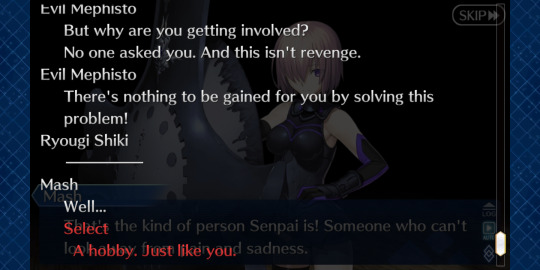
So the KnK event is one of the only few times we really get a chance to look into Meph’s character, but quite honestly im so happy that they wrote Meph the way they did. The MOST we have from his profile is that the Meph we summon is nothing more than just a homunculi summoned in the image of the actual demon, that Faust had only produced a single being based around the idea of betrayal. But Meph himself has had scattered appearances just randomly helping Guda, and he’s such an underrated character because all his posturing hides what he truly is: a goddamn little clown rat bastard who loves Guda so DAMN MUCH
So already in KnK, one of the first things we learn is that Meph was split into a good and evil half, and that as you go through, he constantly reminds you that he’s nothing but a monster, up until you get to see his multiple evil incarnations.
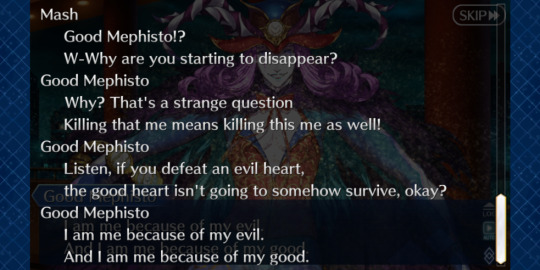

Meph has a lot going on here, but the main thing to note is how his incarnation here is based around the duality of what he really is. Is he a devil or a person? good or evil? human or not? He will never tell and that’s more important than the actual answer. The entirety of Meph’s character revolves around how he loves Guda for their humanity, he understood from the START that Guda wasn’t saving humanity out of altruism but rather because they personally wanted to survive and do something about it. The good Meph disappears along with his evil versions because they are, despite his explanations, functionally the same. We assume that a “good” Meph is one who is helping to stop the singularity while the “evil” Meph is one who wants to keep it in place, but Meph operates on a different logical basis. To him, he is his “good” half because he has every excuse not to betray Guda and thus IS “good” because he isn’t playing the role of a betrayer, while the “evil” Meph is one who betrays Guda from the very start by working with Goetia/Dantes, setting himself up as just an enemy that needs to be defeated because hell, he’s a demon remember? He’s more evil than good and that’s why he must be defeated. But that doesn’t mean the good inside him never existed, that despite his purpose of betrayal, he can’t genuinely admire humanity. He is who he is because of both his evil and his good, defining his weakness as his lack of inherent humanity while considering it Guda’s greatest strength.
Speaking of Dantes, he is a very important player here because we know that the reason the apartment building couldn’t become a singularity was because Edmond, despite being controlled by Goetia, still loved humanity too damn much to go against them, which is why he basically set himself up to fail so that he could escape the influence of the Demon Pillar. Dantes likely chose Meph as his partner to this aim because Dantes understands that Meph, despite all their posturing, LOVES humanity. Meph loves the thing he truly cannot be, which is why he loves watching humans struggle, he loves seeing them succeed despite everything, and Dantes is very much the same. Meph stands against Guda not because he’s a demon of betrayal but because he wants to have Guda grow from their experiences, he truly believes that humanity can overcome the Grand Order. He loves humanity truly and deeply.
And its part of what tears him up on the inside, because he can never be human.

Meph’s interlude is very interesting specifically because of how little it tells us about him. We go through a dream sequence where we help Meph plant explosives to kill what he describes as “a very bad person”. Now, ALREADY that raises several flags by itself but the main thing that makes the sequence suspicious is how Faust was waiting for them at the end. Faust recounts how he regrets having created Meph and that he is nothing but a failure to be stamped out. And Meph doesn’t correct him on any of this. Rather, Meph criticizes Faust for being a boring person who committed atrocities for no reason. It’s one of the few instances where we see Meph actually both mad and righteous, hating that Faust was someone who sacrificed human life for no reason whatsoever. But Meph does agree with him on one thing: He is a failure and a mistake. Faust is a bad person not solely from the tragedies he caused, but because he created the homunculi Mephistopheles. And Meph set this whole thing up to tell Guda that, that he is nothing but a mistake who will betray his master no matter what he himself wants, because he’s the demon of betrayal. This wasn’t a memory or a trip into a singularity, this was a demonstration Meph set up to prove a point, something that he ALSO does in Jeanne’s interludes, where we see the best of his character.

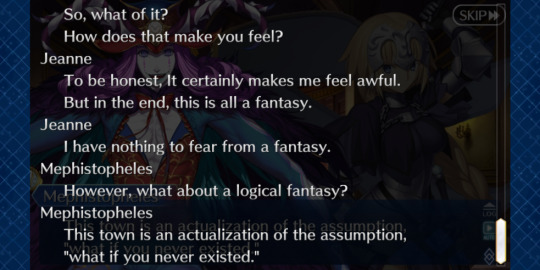

So right off the bat: Meph fucking HATES Jeanne. But he doesn’t hate her because she’s always being a good righteous person, rather he hates that Jeanne holds no resentment towards how unfair her existence was. Meph THRIVES on people acting as they would, but Jeanne herself is almost insane in how she is pious. I expand more on that particular reason why here but Jeanne doesn’t believe in her own future. She believes specifically in the present and that her own existence was always meant to be short lived. And Meph can’t accept that kind of thinking because he himself believes so greatly in humanity’s ability to change. That he wants to change himself. Meph is a monster who understands what he is which is why he puts on the facade of being just a demon, but he yearns to be human, and seeing someone throw that away makes him livid.


Jeanne further drags Meph’s clown ass in her second interlude, where she quite frankly snatches his wig and shoots it straight into the stratosphere.

In this interlude, Meph sets up a scenario where Jeanne would be forced to choose between saving her own mother and the bishop who burned her to death, and in a display of massive big dick energy Jeanne jumps ship to free the spot for both of them to be saved. But Meph here doesn’t criticize her self sacrifice, rather he sees this as Jeanne forgiving Pierre and he can’t understand that.
But she never did.
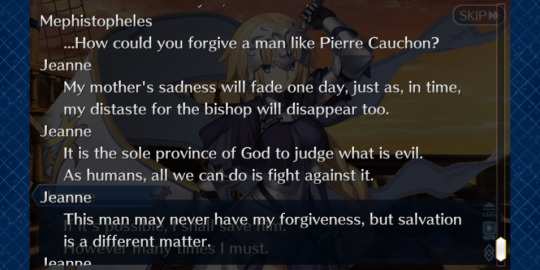
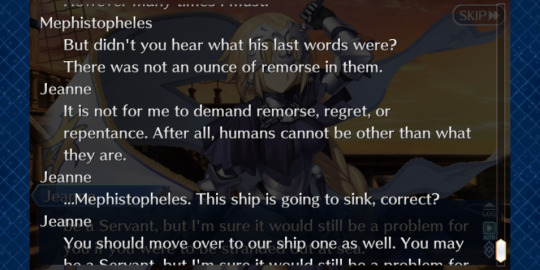
It’s important to remember that Meph isn’t human, and he’s not even a demon. He’s just a homunculi, a copy made in the image of the demon who just has the prime directive of betrayal programmed into him. Jeanne might not have meant it, but she quite frankly hurt his feelings right here. Because he’s a demon but not really, he loves humans but can’t really be one, and Jeanne in saying that humans can’t help their nature just absolutely owned Meph and his nature of being a betrayer. Meph doesn’t hate Jeanne here, but he fears her, because shes basically throwing away her humanity in service of God. Going back to Meph’s own interlude: he hates people who are boring, he hates suffering without any purpose behind it, and he hates people who don’t appreciate what they have. Meph knows the types of atrocities that humans are capable of, and that excites and scares him, but he’s more blown away by the fact that Jeanne can just turn the other cheek to the crimes committed against her.
It isn’t her place to make that type of judgement on other people, she says, but Meph can’t take that type of disrespect standing.


He admits to his loss that he can’t make someone like Jeanne bend to her emotions, but he can make her admit to her own humanity outside of her piety even for a moment. Meph tells her that this was entirely just a game that was set up to have Jeanne show her true nature, but Jeanne’s true nature as a completely self sacrificial individual was something Meph could never understand. If Jeanne was even the tiniest bit resentful of her circumstance, Meph would have completely accepted her. But Jeanne isn’t. Instead, Jeanne tells him that no matter what type of despair an individual faces, what atrocities they may have committed, salvation is something possible for them.
Meph yearns for that. He WANTS salvation in the sense that he wishes to be like the humans he loves so much, but he’s also terrified of them because they’re so much more hardcore than he as a demon ever can be.
SO. Whats left for a demon of betrayal to express the love they hold for humanity? How can they reach the humanity they love and fear so deeply? Well, if betrayal is the only thing he’s good at…

What greater betrayal is there than that of his own role as a betrayer?
232 notes
·
View notes
Text
Jona’s 5 Worst Dramas of 2019
A couple words about this list. I’m making this for fun. If a drama you love ended up on this list, it doesn’t mean that I hate you or I think you’re stupid or have terrible taste. But these are dramas that inspired strong negative reactions in me for one reason or another, whether that be disappointment, rage or disgust.
I’ve only included dramas that finished airing in 2019 in my selection process. If you have some dramas that hated, feel free to share them in the replies or send me an ask. It’s fun to complain about things for some reason.
Also, I have included major SPOILERS in a couple of these. So read at your own peril.
Dishonorable Mention: Melting Me Softly

I sincerely tried to limit myself to only dramas that I--for whatever misguided reasons--finished in their entirety for this list. Mainly because I don’t think it’s fair to brand something as the “worst” of anything without actually giving the thing a fair shake. That’s the only reason Melting Me Softly isn’t higher on this list. But I felt that it wasn’t right to leave it off entirely, if for no other reason then out of respect for the fallen Ji Chang Wook stans out there who lost their lives trying to make it through this trash fire. Somebody needs to stand up for those brave soldiers, out their gifing trash dramas while people like me are safe and sound on our couches, watching the tag like it’s a train wreck.
I made it through only two episodes of this drama, and despite my goodwill toward the majority of the cast, they were two of the most bafflingly bad hours of television that I forced myself to sit through this year. From what I could tell while side-eyeing the drama on tumblr and twitter it didn’t improve much over the course of the run. There were a couple steamy kisses that I enjoyed in clip form, but I don’t think it would have been worth the brain cells lost to sit through any more than that.
Bottom Line: Painfully unfunny, overwhelmingly expositional with no character development, confusing pacing and sloppy editing. Two episodes was two too many.
5. When the Devil Calls Your Name

It pains me to put this on the list because it was just last year that a Jung Kyung Ho, Park Sung Woong collaboration (Life on Mars) ended up in my top 5. And giving credit where it’s due, the two male leads seem to have a great deal of fun working together and I believe that all the actors gave this drama everything they could and sincerely tried to make it work. That’s one of the things I like about Jung Kyung Ho, he picks unique, risky projects that either pay off in a big way or fall flat on their faces (like the amateurishly written and edited Missing 9) Unfortunately, this script just too messy and too bizarre to work. Ha Rip as has a deeply frustrating character arc. He’s such a self-centered jerk for the vast majority of the drama, which is fine for a Faust type story if it’s written with conviction, but every time you think he’s started to turn a corner or grown as a person he reverts back to his old ways. The writing and tone are whiplash inducing. Plus the vague “soul mates” relationship between Ha Rip and Kim Yi Kyung seemed to want to have it both ways, flipping between implied romantic potential and a father/daughter dynamic, which made me quite uncomfortable.
Bottom Line: This drama’s bizarre mythology and world building barely makes any sense at all, but at least they’re easier to follow than the character development. Attempted something unique, but couldn’t pull it off. The OST is super dope though.
4. Love in Sadness

When I watched the first teasers I got the distinct impression that this wasn’t going to be a good drama, or at best it was going to be a guilty pleasure, but at the time when I started it I was hungry for a melo and there wasn’t much airing to hold my attention so I started it on impulse. I think in this case I got what I deserved for continuing to watch something I didn’t think was very good.
The first few episodes were actually pretty gripping and intriguingly dark, but that petered of quickly and the drama became and infuriating wheel spinning exercise with barely any perceptible plot development from episode to episode. The protagonists in this are all so stupid that in the final few episodes the female lead gets kidnapped not once, but multiple times because she keeps meeting her unstable husband alone. Plus nobody in this drama seems to know how to call the police when a madman is waving around a gun. It probably wouldn’t have made me so very mad except that in the last few episodes the writer became unaccountably preoccupied with how sad the psychotic, wife-beating husband’s family life was and how lonely and pathetic his life was when he wasn’t allowed to stalk, assault, and psychologically terrorize his wife. Seriously, in the last leg of the drama the villain is the only character who gets any character development at all. The drama pulls out all the stops to try to make use feel sorry for him. It’s disgusting.
Bottom Line: When a drama about a woman trying to escape domestic violence becomes completely preoccupied with painting the abuser as tragically misunderstood, you’ve got some serious problems.
3. The Lies Within

If it wasn't for the last two episodes this drama would not be on this list, but that isn't because it was in any way an exceptional drama, or that it otherwise would have ended up on my best list. Without the last two episodes The Lies Within is a merely adequate thriller, somewhat heightened by the brutal nature of the premise. I picked this show up largely to fill the void that was left by WATCHER and it was more or less successful, plus it helped that I liked the cast. However even at the beginning this drama I felt like it had some pretty glaring tone problems. There were parts of the drama that were standard OCN dark and gritty thriller, and there were other parts that felt like a campy police sitcom. The humor, when it does crop up in this drama always feels super out of place. But then that last big twist happened and man...I can't remember the last time a drama made me that angry or cratered quite so hard with a twist.
[And this is where I spoil the HELL out of this drama...]
Before this drama decided to go all M. Night Shyamalan in it’s last two episodes, there seemed to be at least one, if not two really reasonable candidates for the kidnapper. Actually all the ground work they’d done up to that point would seem to have pointed to Young Min and if he had turned out to be the perpetrator, I would have completely bought it. Instead they decided to blow everyone’s mind by making the kidnapped husband complicit in his own kidnapping and dismemberment. Which might seem like a shocking twist until you think about it for even half a second.
What it winds up doing on a narrative level it makes everything the characters have done to investigate this series of crimes up to this point feel pointless, resulting in a huge anticlimax. It makes the ambiguous figure of Seo Hui’s husband not only hopelessly stupid, but also cruel and unsympathetic. Because he thought somehow simply sharing the information with her would put her in more danger than threatening and psychologically terrorizing her into investigating the very people he was theoretically trying to protect her from. The explanation that he was already terminally ill doesn’t to anything to mitigate the stupidity of his plan for me. Seriously, you couldn’t think of any solution aside from cutting bits off yourself and sending them to your wife in the mail? I could rant about this ending at length, but I’m going to try to stop here.
Bottom Line: As far as I’m concerned, if you choose to sacrifice the emotional and narrative coherence of your story for a cheap and dirty twist to surprise the audience, you deserve every ranty review you get.
2. Love Affairs in the Afternoon
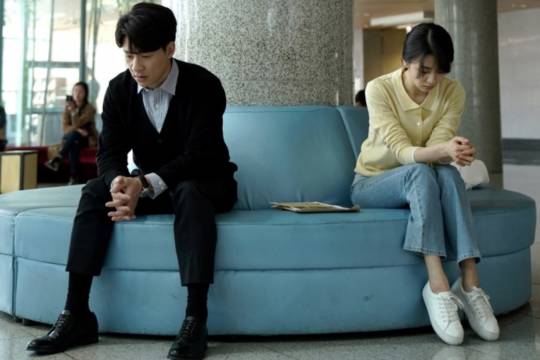
I’m really not sure what possessed me to watch this drama to begin with. That I continued to watch it is on me. The fact that I watched it despite hating the shallow characters, the thin story and the abortive message at the core of the drama is simply a lapse of judgement for which I shouldn’t be forgiven. Why did I do it despite not having a single nice thing to say about this show? Well, there are two reasons. I was curious to see if they would do anything compelling with one or two of the characters, (specifically the serial adulteress housewife an the broody artist) and I was surreptitiously watching this drama at work and it was really easy to follow the plot while only actually keeping my eyes on the screen about half the time. I watched the last episode before the subs were available and had no trouble understanding what was going. Which could be a sign that my Korean is improving, but is more likely a sign that the writing was so predictable and simplistic that you could follow it if you didn’t speak the language at all.
[Spoilers beyond this point.]
It’s my understanding that in the Jdrama that this is based on all of the characters basically wreck their lives and end up miserable, pointing toward the emptiness of the lives of these people who try to find fulfillment through extra-marital affairs. If that’s how this drama had ended, I still wouldn’t have enjoyed the execution but I could have respected the intent. But in this watered down Kdrama-fied version all the couples’ issues are resolved in the whitewash of a last episode time skip that makes the suffering and bullshit that led up to it feel completely pointless.
Bottom Line: Maybe this level of trashy, uninspired tripe would be somewhat justified if the chemistry between the leads had been better, but somehow they even managed to screw that up. The leads are just bad, vacuous people, a fact which is rendered all the more unforgivable by them being utterly bland. Everybody needed to divorce, nobody deserved to end up happy. Please be wiser than me and avoid this one.
1. Memories of the Alhambra
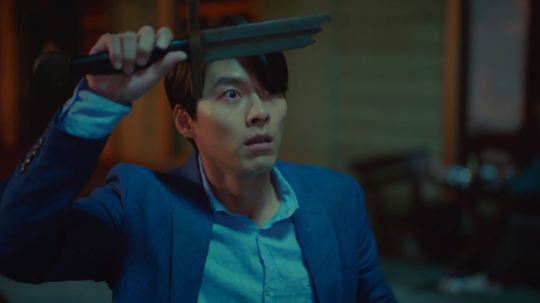
Initially, I was on the fence about even producing a “Worst List” this year, because in the past few years I’ve tried to be better about dropping dramas the moment they start to disappoint me, rather than hanging on to them and winding up burning myself out. I wasn’t sure if I’d have enough material to write this list, or at least not enough material to make it worth reading. Then I remembered that Memories of the Alhambra finished airing in January of this year (2019 was impossibly long, wasn’t it?) and I thought, “Aha, I can make this work.” I knew at once this drama was going to be the shitty tinfoil star atop my Christmas tree of suck.
I’ve already written a full review of this drama, where I got about as mean as I felt I could reasonably be. You can go read that if you like, I’m not going to retread all my many complaints here. What I will say is that Memories of the Alhambra took my mixed-to-favorable opinion of the writer, Song Jae Jung, and turned it to a negative one. She’s someone who clearly has a lot of interesting high concept ideas, but the execution is just not there. You can hook an audience with a concept, but you have to keep them with craft and structure.
Maybe the industry can be blamed for that. Maybe she just has a hard time ending her stories, or maybe writing on a deadline doesn’t agree with her. Whatever the reason, I can no longer trust her to deliver a satisfying story. And that’s deeply saddening to me, because Queen In Hyun’s Man is in my top 10 favorite dramas.
To be front-to-back terrible is one thing. The joke’s at least half on me for bothering. But to have potential, to have an interesting hook, a budget, a cast, but then to be either unwilling or unable to live up to that potential feels like a con. That’s how I felt about his drama, like I had been willfully deceived by special effects and flashy editing, all orchestrated to disguise a narratively bankrupt, unsatisfying drama.
Bottom Line: Is Memories of the Alhambra objectively the worst drama on this list? No, it’s not. Is it the most disappointing? Absolutely, it is. And that’s the more heinous crime, in my opinion. And that’s why it’s my worst drama of 2019.
25 notes
·
View notes
Text
[Review] Kamen Rider Build - Episodes 34-37
Time for a month of episodes where some stuff happens. The most important thing to happen is me finally catching up with the show!
Small disclaimer now that we're in Evol territory: If it weren't obvious, I flip between character name and Rider name (Sento / Build) depending on whether they are transformed during a scene I talk about, so if you see me saying Evolt or Evol, that's not a typo. That's just the show deciding to give them such similar names. Carry on.

Episode 34: “The Best Match Severed” (離れ離れのベストマッチ)
So Kamen Rider Evol is a thing, the prime minister is dead, and Gentoku might have emotions. Following that heavy ending to the last episode, Evol decides to poison Sento with the promise of a cure in return for - you guessed it - all of the Fullbottles and Pandora's Box. While Ryuga and Kazumi reluctantly meet him at the box's location with all of the bottles, it turns out the poison can only be cured if Evolt is defeated, which means they'll fight for Sento's life. Vernage's powers don't seem to be enough to help, as Evolt even remarks that her powers are just remnants at this point.
Of course, since Evolt has proven himself to be less than trustworthy, this goes poorly. Cross-Z Magma might have the stronger form, but he can just barely make a dent in Evol. It doesn't help that he's been given quite the realization, as Katsuragi previously wanted both Evolt and Ryuga dead since they are more or less one and the same. Also real talk? Kazumi says it's dangerous to transform again after you've been forced out of a transformation, which I don't think I've ever even heard being addressed in a toku - props.
With one literally heated rematch between Evol and Cross-Z Magma, the finishers clash and we end the episode with Ryuga standing in the flames left by their battle... and the reveal that Evolt has taken on the form of Ryuga! As you'd expect, Evolt was lying about Sento's poison only being cured that way, so Sento is healed and only just aware that something is amiss here...
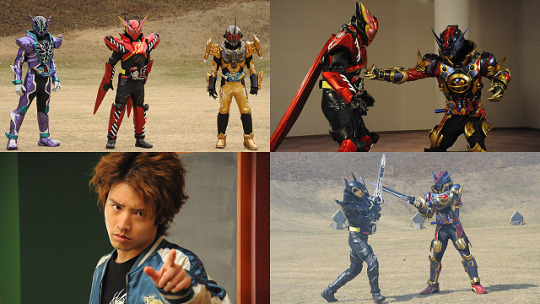
Episode 35: “Tower of Destruction” (破滅のタワー)
Hot off the heels of the last episode, Evolt transforms into his new Dragon Form, which makes use of Cross-Z's helmet design. He's basically just showing off as he decides to stroll into the building to get Pandora's Box and ditch them. Sento won't take that sitting down, so despite literally just crawling out of an ambulance, he's ready to fight Evol.
This is when we get the full context of what's going on with Ryuga. As it turns out, the substance that made its way back from Mars was a part of Evolt, which was attempting to possess Ryuga's mother, but accidentally possessed the baby in her womb. So technically, Ryuga isn't the space baby I figured, he's just a human who got possessed by alien powers that fused with him to the point they remained dormant. So as Blood Stalk, Evolt was constantly raising Ryuga's Hazard Level for the sake of making him strong enough to fuse with, basically. Damn. That all comes together nicely.
After all that exposition, Evol ditches Build with the bottles and the box, but he forgot one! More on that in a sec. For now, we get something I wasn't expecting: Soichi is separated from Evolt, as he's in Ryuga's body now. In true toku fashion, however, he's in the hospital for now so we can't actually find out what he has to say yet. To be fair though, Evolt did kinda let himself deliberately take a LOT of beatings leading up to the Evol Driver reveal, so he deserves some rest.
More on that bottle. I dunno who to credit for this cleverness, but Gentoku still had the Phoenix Fullbottle with him, meaning Sento wants to work together against Evolt. However, before they can really strike up a deal, Evolt forces them all to the middle of Pandora Tower for his big moment.
As you'd expect, everyone would rather punch him than let him do what he pleases, but that doesn't go so well to say the least. As it turns out, Evol is now acting against Namba since he's OPENING Pandora's Box, so it's up to Utsumi to go order Evol to stop - which goes as well as you'd expect. With no one capable enough to stop him, all 60 of the Fullbottles are in place and Pandora's Box - as well as Pandora Tower - is fully formed!
This would be a fun time for the show to take a week long break due to sports, but we've been pretty lucky in that regard.
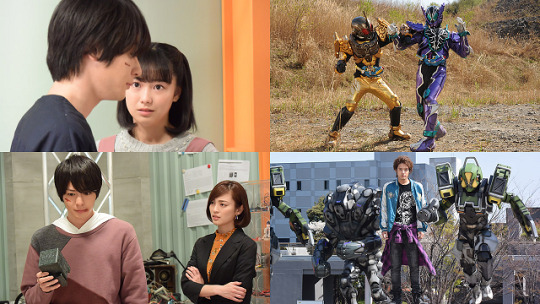
Episode 36: "Evolt the Planet Hunter" (エボルトは星を狩る)
With Evol unleashing the power of Pandora's Box, he pulls out an item we know to be the Evol Trigger, claiming it will bring him to full power. Unfortunately, he can't use it just yet for some reason, so what seemed like a finale moments ago has now been cut short. Although, as he assures Namba, Seito now has a stunning display of power they can use to intimidate Toto.
With Vernage making a quick rescue, we also learn that the Fullbottles of Pandora's Box were actually made from Soichi's memories, which is an interesting thought, and contained Evolt’s power. Sento also discovered that a bit of his father's research involved a way of using a Pandora Panel to create a special transformation item to counter Evolt's power, which sounds quite deadly. Misora catches onto the fact that he's going to sacrifice himself for the good of others again, and gives him a reasonable talking to since he is still feeling those sins crawling down his back - this is a fascinating conundrum they've cooked up for a protagonist, damn.
Meanwhile, Kazumi has a score to settle with Gentoku. It seems like after all their fights, he's become much stronger than our purple edgelord, though it probably helps that Gentoku is also emotionally vulnerable right now. Kazumi lets out his frustrations over Gentoku killing Akaba, but he understands that if Akaba were still here, he'd probably think he's being a little petty about it. Since he won this fight, Kazumi gives Gentoku one request: Someday, whenever he's ready, become their ally. Very cool scene all around.
As Seito once again makes Toto a dangerous place to live, Build takes on Evol, showing that he's actually becoming strong enough to take on Evol's default form - glad they showed that since the FullFull armor forms seemed like they were quickly outclassed. Build tries using the blocky transformation item and manages to do some damage, Evol puts a hand into his body (context), and Build reveals that his father's invention was intended to foil Evol's strategies and he uses this opportunity to raise his Hazard Level rapidly and blow them both up.
As the smoke clears, we're not left with Evol or Build... but a white-haired Sento. Ryuga is separated from Evolt, and it turns out Sento's plan failed, so Evolt has the body of our strongest hero. Using his new Rabbit Evolbottle pulled from Sento's body, he taunts them all with a form reminiscent of Build...

Episode 37: "The Ultimate Phase" (究極のフェーズ)
Using his newly obtained form, Evol is now on Phase 3 of his personal level system, and makes quick work of Grease by... what I assume was destroying his Sclashjelly, but I guess he just made a little mess with it. And he didn't even have to do anything to Ryuga, because he took back any DNA left on him, making Ryuga a completely normal human who can't transform. Vernage makes a desperate attempt to escape by taking the entirety of the cafe and their lab, and repositioning it ssssomewhere by the sea? Sure. Be interesting to see the reaction to that later.
Ryuga and Kazumi make desperate attempts of their own as they come to Gentoku, at Faust's old hideout, to try and give Ryuga a Hazard Level again. But Gentoku is honest about how he doesn't really know anything about science, and the process involved Evolt, so... they're out of luck. Kazumi however does give an awesome speech about how Sento always fought for love and peace, and in some way, they were all fighting for the same thing. Interesting tidbit dropped here where Rogue’s gear apparently can only be used when a certain emotional drive is involved, and as we've learned, Gentoku is pretty drained of motivation lately, so he's in as just of a bad place as Ryuga...
It's really just up to Grease to try and take on both Evolt and the gear bros, but just as Grease becomes outnumbered, Rogue shows up! With a refreshed outlook on life, he's decided that his father doesn't have to be the one to run Toto, and neither does he - but he can sure make way for a brighter future regardless. The combined strength of these two still isn't quite enough to challenge Evol's power - he's proving just how much of an endgame villain he is.
That's when Ryuga pulls a Sento and gets a clever idea. Wrestling off the Dragon Evolbottle from Evol's arsenal, he attempts to use it to punch the heck out of him, only for it to actually work! It turns a gold color, and the Cross-Z Dragon flies over to him, turning red as he inserts the new bottle. Using it in the Build Driver, he transforms into Great Cross-Z, which is... basically the original Cross-Z with some Evol-y colors here and there. Not as great as you’d expect.
In his new form, Cross-Z is surprisingly doing damage to Evol. Not only that, but his Hazard Level has in fact returned proper, as he switches to Cross-Z Magma and proves to be a formidable force. As the three Riders huddle together for a finisher, though, Evol blocks it with the Evol Trigger and lets it absorb their energy, allowing it to truly awaken.
Now Evolt, as Kamen Rider Evol, uses the Evol Trigger in the Evol Driver with his Evolbottles (NAMES ARE HARD) and transforms into his Blackhole Form - the final form. What a twi--
Oh, and Sento has been separated from Evolt,and he's back to normal... which means he no longer has amnesia and is now aware that he's Katsuragi Takumi! WHAT. A. TWIST.
So Build's doing pretty damn well. It has been high stakes for a while, but now we are in some heavy end game territory with plenty of episodes to spare. I am super interested in seeing where this Katsuragi thing goes.
These four episodes in particular were a lot of fun to marathon since they are so connected - it felt like a Steven Universe bomb done right, y'know? The one with the zoo? Good times.

Oh and since I know I’ll be asked about it: Yep, the magazine reveals for May did in fact include Kamen Rider Mad Rogue, who won’t be appearing until the next episode. The magazines show off what’s appearing in that month, though there are exceptions when it comes to movies/spinoffs. Regardless, this was an odd one to see in the magazine and not in the show.
I think their reasoning for this was probably to do with the DX BatEngine Fullbottle Set being released alongside the DX Evol Driver - people who aren’t following spoilers will probably wonder what those bottles are for and why the promo images specifically involve using the Evol Driver for this set of bottles.
24 notes
·
View notes
Text
Well, either of your ideas that you had written was already written before (albeit differently) by someone else a while back basically (out of the fact that I made questions similar to the ones I gave you which resulted in tumblr bloggers giving me different answers to them).
gingerly-writing: to this ask I filled out for them. I’m pretty fucking pissed off, and I’ve had my fury checked out by uninvolved parties to make sure it was righteous. It’s righteous.
Me: Not entirely so.
gingerly-writing: First off, feel free not to send people rude-ass messages after they’ve put time and effort into coming up with a response to you?
Me: The top comment there (the “Well, either of your ideas” comment) wasn’t really the rude comment I typed out. The other one was (which I’m sorry for) which you didn’t copy paste in your third post so other bloggers can see it as that public evidence is vital for context.
gingerly-writing: Also, I thought you were going to use my idea and have me to thank you or something for it when I came up with something like my asks I gave you and something to the equivalent of your “heroes and villains school” stuff before I replied to your ask box sometime ago. Basically, wanting me to give you undeserved credit for my very own idea. I certainly didn’t know you were going to make comments like this either.
So, I actually have a hero and villain school in my own original superhero works, and I did come up with a solution to this one. If you’re writing your own original stuff, please change this up, but if you’re writing fic I don’t mind if you nick it wholesale (as long as you tag me in it! I’d love to read it).
Y’know, for me, this was just background information, but now I kind of want to write a whole book focusing on it.
gingerly-writing: It took me a good 45 minutes to get tumblr to accept my answer to your damn ask, so you’ve just made that a waste of my time.
Me: Maybe. But, from below, you were not bettering the situation.
gingerly-writing: Also, feel free to simply not respond rudely to people’s posts, at all, ever, especially if you were the one who sent the ask in the first place. I didn’t need to know how shit my ideas are, thanks.
Me: Yeah...not really sure where you’re going with this. Are you saying your ideas were horrible because they were based on my idea and how I spread more around on tumblr? Or do you think I’m saying your ideas were horrible because you think I’m somehow saying, implying or thinking that?
Either why, that comment of yours was not helpful for anyone. Yourself included.
gingerly-writing: Also, as a more general PSA, feel free not to send identical asks to multiple bloggers.
Me: Not happening. As I can sent any ask at any time by my own free will. As is my right.
gingerly-writing: Seeing someone else answer the same ask really disincentivizes me to answer it, even if it’s in my queue: I worry about stepping on the other responder’s feet,
Me: Well, to be fair, I can understand the sentiment there. Still, what you say next will lower that sentiment.
and also, it’s motherfuckin rude, you absolute assclown.
Me: Childish name calling. So...how is it you’re any better with what you had said. What would you benefit from doing that other then venting out your anger. ...Which ironically enough I didn’t even do here and wouldn’t now just so I won’t sink to your level of rudeness.
gingerly-writing: And if you do send multiple asks and get similar responses, maybe it’s simply because it’s a good fucking idea. If you get different answers, maybe it’s because we’re all different fucking people with awesome different ideas that I’m not sure you deserve.
Me: You know what, I’ll be upfront, and say that I should have not jumped the gun and assumed the worse and could’ve worded my comments better (or just replied privately about the whole matter), you, on the other hand, didn’t do much of anything to resolve the situation as best as you should’ve. In the end, you basically became me. But a little worse.
gingerly-writing
: feel free to block me on the way out
Me: Already did. I’m hoping you don’t treat other bloggers the way you had treated me. Especially if they were nicely bringing up stuff to your attention among other things. And especially, even, in the ‘ginning once they asked you something.
gingerly-writing: #I try to be nice on this site #but I have my limits #and now I'm in rage mode #the asks and the answers #rude #ungrateful
Me: As if you were better with your own fair share of rudeness that might be on the level of hackedmotionsensors’.
hackedmotionsensors: THIS PERSON IS SO WEIRD!! All they ever do is send these bizarre questions about the DCEU being in MCU!
Me: Actually, that's not ALL I do. I asked other questions too. And my qs aren't as weird as any one else's either, hacked. Best to not go by assumptions and call people weird for what they say or do. Be it in front of their faces or behind their backs. Also, don't like me or my qs? Then either block me or just blacklist my name.
See ya...never, I guess.
------------------------------------------------------------------------------------
Here’s some context on what I was talking about on this post:
TumblrFrostbite: How would you want schools for villains' kids (for Marvel villains' kids, for DC villains' kids, etc) to be ran? And who would you want to run those schools?
gingerly-writing: This is one of those things that I’ve put way too much thought into after you sent this, because I love stuff like this. The question is, are the villains running this school for their kids, or is this something the heroes are putting on to try and rehabilitate the kids while their parents are in prison? I’ll assume the former, but the latter is also super interesting to me.
Disclaimer: this will have a strong DC bent because I have little to no interest in most Marvel villains, whereas I could yack on about DC villains for month. In fact, I might just stick to DC in its entirety because other than Loki (who would be the worst teacher ever, he would encourage so much shenanigans) most of the Marvel villains I know are Nazis or space monsters.
Second disclaimer: I’ve watched a lot more animated DC movies and read a lot more fic than I ever have comics, soooooo these depictions might not be comic book accurate. Fanboys, please don’t come for me…but I also don’t really care that much tbh. I like the incarnations that I like. ¯\_(ツ)_/¯
Actual answer under the cut because this got hella long. Hope you like it!
Sponsor: Lex Luthor. Funds the school, shows up to speech day to give speeches and hand out prizes, gives the brightest and most stable kids scholarships to work at Lex Corp in the holidays. Absolutely 100% has his own ends, no one knows what they are. Chucks buckets of money at every problem. Likes to bring the school up at fancy soirees in front of Bruce Wayne and Oliver Queen just to piss them off.
Headmaster: Deathstroke (or rather, Slade from Teen Titans). Has no idea how he wound up with this job, complains about the pay 24/7 even though it’s in the range of millions of dollars a term paid in untraceable cash from 50 different countries. Basically ends up like Gordon Ramsey: threatens to assassinate the teachers and parents all the time, has actually taken out some abusive parents, but is weirdly, gruffly nice to the younger kids. Teachers self-defence to all the non-powered kids and weapons to anyone who’s interested and has the discipline for it. Grudgingly tolerates old man jokes.
Deputy Headmistress: Talia al Ghul. Absolutely terrifies all the older kids, mothers the younger ones. In charge of who graduates and who doesn’t; will only let kids graduate if their villainy won’t critically endanger their own life. Sometimes shows up in the backs of random classes and lurks there for ‘assessments’; shows up in more than 50% of Deathstroke’s classes to harass him about his technique. Keeps a photo of Damien on her desk, refuses to acknowledge it’s there if someone asks about it.
Biology: Poison Ivy. Excellent teacher, surprises both herself and her students at how brilliant she is. Everyone wants to take biology with her even if they have no villainous interest in the subject. Litters her lectures with feminist rants, eco-warrior tirades and talks about LGBT+ rights, will gently but forcefully correct anyone who disagrees with her. Runs a vegetable outside the school and encourages the kids to get closer to nature. Just enough passing knowledge of memes to make her older students roll about with laughter: ‘Batman’s homophobic because he inconveniences me and I’m gay’. PDAs with her girlfriend in the corridors.
Women and gender studies: Harley Quinn Ivy’s girlfriend, part time teacher. Wanted to take up the psychology post, but after she seriously suggested sharing it with Jonathan Crane (Scarecrow) no one wanted to let her anywhere near it. Knows every meme. Gives great relationship advice, will kill anyone’s abusive boyfriend with no questions asked. Brings her hyenas to school in a ridiculously massive handbag. Has her own locker.
Thievery, sneaking around, Gotham safety: Catwoman. Definitely brings in her cats to act as therapy/comfort animals for the kids. Unofficial therapist; absolutely mothers anyone from Gotham, no exceptions. Brings the kids super expensive (stolen) jewellery to wear on prom night and for big dances, charges in secrets about their parents.
Business and Economics, with a side in mind control: Maxwell Lord (in the more business-orientated editions). Keeps to himself, is one of those teachers who doesn’t actually seem to like kids. Always wears a freshly pressed suit. Bit of an asshole. Selina tripped him down the stairs once.
Magic: supposedly taught by Felix Faust, but Klarion enrolled as a student just to show up in his lectures and argue. Every. Single. Point. Magic classes have turned into a magical war several times. They can only get along when someone else turns up claiming magic isn’t real. Faust has a lecture prepared for the non-believers, Klarion has a fireball. Circe often shows up in these classes, ‘borrows’ all the female students for private lessons and turns all the boys into pigs. Pig-Klarion does not appreciate this.
Physics and advanced thermodynamics: Killer Frost. Gets on really well with the Gotham City Sirens; they have cocktail parties in the staff lounge every second Thursday. Is paid by other villains kidnapping Firestorm so she can feed. Absolutely has favourite students and students she hates with a passion; has been known to freeze some students to their chairs in lieu of detention.
Other random villains that show up from time to time:
- Flash’s Rogues Gallery. Created the infamous ‘Rogues week’ at the end of the year where every single one of them shows up and helps the students wreak absolute chaos across the school. Can never be stopped from showing up and starting this. Captain Cold comes grudgingly, sits in Slade’s office and has a drink with him; the rest of the Rogues join in with the chaos a bit too enthusiastically. Best week for the seniors. The younger rogues would totally be students and help to smuggle the older ones in for Rogues week.
- Black Manta: shows up sometimes, teaches a few lectures, leaves. Always on super random topics, often tangentially related to his latest evil scheme. The students have a betting pool that reawakens after each visit on how his talk will relate to his next scheme. Literally no one understands why he shows up. Doesn’t get paid, doesn’t seem to enjoy it. ?????? Has great on-land fashion sense though. A lot of the older students have lowkey crushes on him
- Cheetah takes advanced genetics and many other complex of aspects of science. Only shows up to teach special classes for the seniors. High fives Ivy in the corridors.
- Deadshot. Sometimes shows up and interrupts Deathstroke’s guns lessons (poor guy can never teach a lesson in peace), always gets chased out of the school. Gets teary eyed over the young female students kicking ass. Doesn’t seem to do anything useful but somehow gets paid a salary. Sleeps in the gym when he’s on the run from Amanda Wakker/Batman.
- Hugo Strange keeps showing up in disguises and trying to get the psychology job. Last time it was just a fake moustache. What is he even hoping to achieve.
- Merlyn shows up when he’s bored to host archery competitions on the front lawn. Mostly does this when Oliver Queen is in town. Keeps saying he’s going to pick a protégé out of the best archers and never does because the Arrow Clan kids annoy him so much he’s wound up thinking he hates kids. Actually loves kids, pretends to be snooty and above them though. 100% has to prove he’s still the best archer at every competition, even the one for 12 year olds.
TumblrFrostbite: If the super villain academy children, by the time they hit twenty, had to do some VERY impressive villainous in order to graduate, what type of villainous stuff would you have the rookies villains do to not only graduate, but also to be considered as full fledged villains?
gingerly-writing: So, I actually have a hero and villain school in my own original superhero works, and I did come up with a solution to this one. If you’re writing your own original stuff, please change this up, but if you’re writing fic I don’t mind if you nick it wholesale (as long as you tag me in it! I’d love to read it).
My thought was: all villains are going to be different, with different strengths and gifts. Sending them all to, I don’t know, infiltrate an island or fight Black Canary (which no one would win, let’s be honest) doesn’t seem fair on those it doesn’t suit. I was really struggling to come up with something that could work for everyone that didn’t force them to work in a team, because, well…villainous teams never work so well. Too many egos and whatnot.
My solution was: have the kids pick their own challenges. Make it their end of final year project. They submit a fully researched plan, all the way from the developmental stages to the final polished article. Plans like ‘killing Batman’ or ‘blowing up the planet’ are swiftly vetoed, but as long as they’re convincing enough the plan can get as elaborate and dangerous as they like. Half the marks come from the plan itself, and half for execution. Sometimes, my particularly vindictive kiddos make their plan to screw over their nemesis’ plan; I particularly enjoy when their plans are both to screw over each others’ plans. That gets entertaining.
They’re assigned a teacher whose knowledge base best fits with the plan the kid wants to execute, and they submit and resubmit and re-resubmit it to improve and refine their scheme until it’s as perfect as it’s going to get. Then, with no further outside help, they have to execute it.
This method lets you titivate the grand finale to best suit your plot needs. Your character has a serious nemesis? Pitch them against each other. Parental grudge? Make their aim to foil their parent’s plans. Hero that they hate? Plan to ruin their day. Plus, you can shove in bureaucratic nightmares and whatever other problems you can dream up (sabotage, indecision, dreams too grand to execute) into the planning stages.
I’m not sure you could do anything in a school situation to make the outside world consider them ‘real villains’: that would take time, money, and a body count, all things a school probably can’t afford to have on their books, villainous or not. But a huge, large-scale, dramatic graduating plan probably wouldn’t hurt any young villain’s rep!
Y’know, for me, this was just background information, but now I kind of want to write a whole book focusing on it.
xx
2 notes
·
View notes
Video
youtube

essay writing help
About me
Rare Rembrandt Rembrandt as Printmaker Essay Example For Students
Uncommon Rembrandt as Printmaker Essay A few hundred years after he lived and worked, Rembrandt remains a big name of single-name status; odds are that few a long time from now his work will suffer while that of, state, Yanni may not. Of Rembrandt van Rijns 290 etchings, 85 are right now visible, alongside extra prints of the time, at UVMs Fleming Museum. The visiting display, Rembrandtâ and the Art of Etching, has just been seen by maybe a million watchers in South America, yet Burlington is its solitary North American stop. A while later the works will come back to where most were created: Rembrandts own home, presently the Rembrandt House Museum in Amsterdam. The show offers Vermonters a selective chance to see a considerable lot of the seventeenth century Dutch experts most significant works. Reached by telephone in Boston last week, Rembrandt House guardian Dr. Bounce van sanctum Boogert was asked, Why Burlington? his answer was straightforward: Janie Cohen. The Fleming Museum executive is the co-creator of Etched on the Memory The Presence of Rembrandt in the Prints of Goya and Picasso, and a lot of her exploration was done in Amsterdam. Cohen has additionally contributed compositions to the Rembrandt House. So carrying this noteworthy assortment of etchings to Burlington was a characteristic decision for her Dutch partner. Van lair Boogert will give a discussion on Rembrandt at the Fleming this Thursday. The display contains a wide scope of subjects, including at any rate eight self-representations. In the earliest, Rembrandt was in his twenties. The most popular is likely Self Portrait, Leaning on a Stone Sill from 1639. At 33, Rembrandt appears a practically egotistic youngster, as presumptuous as DArtagnan from The Three Musketeers. In any case, that is an outside view. The craftsmen inward world is the thing that makes the show so interesting, and the mode of carving gives the ideal stage to survey it. Rembrandtâ sold a large number of duplicates of etchings in the course of his life, and was presumably preferable known for those works over for his canvases. His specialized best stuff was top notch, and that virtuosity empowered him to practice the full scope of his expressive forces. Knowledge into Rembrandts imaginative procedure can been found in the two conditions of The Three Crosses introduced in this display. Figures have been included and evacuated between the two states, both made on a similar copper plate. He likewise modified his piece by controlling light and shadow. Another strict print, Christ Healing the Sick from around 1649, outlines two specialized strides in the scratching procedure. A smooth ground was applied to the plate, and that ground was drawn through in an exceptionally immediate manner. At the point when carved, the uncovered metal made generally delicate lines to be inked. Then Rembrandt cleaned and dried the plate before scratching differentiating lines straightforwardly into the metal to add better subtleties to territories, for example, hands, toes and attire. Christ Healing the Sick is arguably Rembrandts most well known scratching, and it figures noticeably in the craftsmen legend. It is otherwise called the Hundred Guilder Print, and a few clarifications have been proffered for that inquisitive moniker. In 1755 a French workmanship seller said that Rembrandt traded an impression of it for an Italian print worth 100 guilders. Another far-fetched story is that Rembrandt repurchased a duplicate of the print for that over the top entirety. Late grant has uncovered a 1654 letter to the cleric of Bruges from a contemporary craftsman that Rembrandts prints had sold for 100 guilders on a few events. That sort of prominence made him a well off man, at any rate for a spell. The Shell (Cornus Marmoreus) of 1650 proposes one reason Rembrandt went bankrupt in 1658. Van lair Boogert clarifies that something as outlandish as a Cornus Marmoreus shell would have cost the cost of a house in Amsterdam. It was for all intents and purposes a seventeenth century moon rock, and The Shell  Rembrandts just carving still life was drawn from an example in his broad assortment of doodads and artistic work. He had likewise gotten into the nearly incomprehensible propensity for making prints for his own satisfaction as opposed to explicitly available to be purchased. The Shell and The Hundred Guilder Print may have been such works. .ud3b16866a5186c774d00b5dd391fce1d , .ud3b16866a5186c774d00b5dd391fce1d .postImageUrl , .ud3b16866a5186c774d00b5dd391fce1d .focused content region { min-tallness: 80px; position: relative; } .ud3b16866a5186c774d00b5dd391fce1d , .ud3b16866a5186c774d00b5dd391fce1d:hover , .ud3b16866a5186c774d00b5dd391fce1d:visited , .ud3b16866a5186c774d00b5dd391fce1d:active { border:0!important; } .ud3b16866a5186c774d00b5dd391fce1d .clearfix:after { content: ; show: table; clear: both; } .ud3b16866a5186c774d00b5dd391fce1d { show: square; progress: foundation shading 250ms; webkit-change: foundation shading 250ms; width: 100%; obscurity: 1; change: haziness 250ms; webkit-progress: darkness 250ms; foundation shading: #95A5A6; } .ud3b16866a5186c774d00b5dd391fce1d:active , .ud3b16866a5186c774d00b5dd391fce1d:hover { mistiness: 1; progress: murkiness 250ms; webkit-progress: obscurity 250ms; foundation shading: #2C3E50; } .ud3b16866a5186c774d00b5dd391fce1d .focused content zone { width: 100%; position: relative; } .ud3b16866a5186c774d00b5dd391fce1d .ctaText { fringe base: 0 strong #fff; shading: #2980B9; text dimension: 16px; textual style weight: striking; edge: 0; cushioning: 0; content adornment: underline; } .ud3b16866a5186c774d00b5dd391fce1d .postTitle { shading: #FFFFFF; text dimension: 16px; textual style weight: 600; edge: 0; cushioning: 0; width: 100%; } .ud3b16866a5186c774d00b5dd391fce1d .ctaButton { foundation shading: #7F8C8D!important; shading: #2980B9; outskirt: none; fringe sweep: 3px; box-shadow: none; text dimension: 14px; text style weight: intense; line-stature: 26px; moz-fringe span: 3px; content adjust: focus; content design: none; content shadow: none; width: 80px; min-tallness: 80px; foundation: url(https://artscolumbia.org/wp-content/modules/intelly-related-posts/resources/pictures/basic arrow.png)no-rehash; position: outright; right: 0; top: 0; } .ud3b16866a5186c774d00b5dd391fce1d:hover .ctaButton { foundation shading: #34495E!important; } .ud3b16866a5186c774d00b5dd391fce1d .focused content { show: table; tallness: 80px; cushioning left: 18px; top: 0; } .ud3b16866a5186c774d00b5dd391fce1d-content { show: table-cell; edge: 0; cushioning: 0; cushioning right: 108px; position: relative; vertical-adjust: center; width: 100%; } .ud3b16866a5186c774d00b5dd391fce1d:after { content: ; show: square; clear: both; } READ: Rembrandt EssayEvery piece in this presentation is outstanding, however one of the most interesting is the 1652 print called Faust in many sources. Goethe promoted the narrative of Dr. Faustus 150 years after Rembrandts passing, in this way, as van cave Boogert recommends, that distinguishing proof isn't undisputed. The elective title, Practicing Alchemist, is most likely progressively exact. In any case, the print may demonstrate that Rembrandt had an enthusiasm for Jewish mystery. His extravagant Great Jewish Bride print of 1635 seemed one year after his own marriage, and a considerable lot of his dearest companions and benefactors were Jews. Rembrandt and his significant other Saskia likewise lived in Amsterdams energetic Jewish quarter. Just one print, a dispatched picture, is known to have been created among 1660 and the specialists demise in October 1669. In the same way as other of his late works, the self-pictures of his last years were surly and contemplative. This can be found in his self-representation from age 42, in which the craftsman holds a drawing needle to perseveringly follow his own maturing highlights. He is wearing plainer garments than in more youthful years, and sits in a dull stay with just one light source an open window on his right side. That Rembrandt is the man who got everlasting.
0 notes
Note
TumblrFrostbite: How would you want schools for villains' kids (for Marvel villains' kids, for DC villains' kids, etc) to be ran? And who would you want to run those schools?
This is one of those things that I’ve put way too much thought into after you sent this, because I love stuff like this. The question is, are the villains running this school for their kids, or is this something the heroes are putting on to try and rehabilitate the kids while their parents are in prison? I’ll assume the former, but the latter is also super interesting to me.
Disclaimer: this will have a strong DC bent because I have little to no interest in most Marvel villains, whereas I could yack on about DC villains for month. In fact, I might just stick to DC in its entirety because other than Loki (who would be the worst teacher ever, he would encourage so much shenanigans) most of the Marvel villains I know are Nazis or space monsters.Second disclaimer: I’ve watched a lot more animated DC movies and read a lot more fic than I ever have comics, soooooo these depictions might not be comic book accurate. Fanboys, please don’t come for me…but I also don’t really care that much tbh. I like the incarnations that I like. ¯\_(ツ)_/¯
Actual answer under the cut because this got hella long. Hope you like it!
Sponsor: Lex Luthor. Funds the school, shows up to speech day to give speeches and hand out prizes, gives the brightest and most stable kids scholarships to work at Lex Corp in the holidays. Absolutely 100% has his own ends, no one knows what they are. Chucks buckets of money at every problem. Likes to bring the school up at fancy soirees in front of Bruce Wayne and Oliver Queen just to piss them off.
Headmaster: Deathstroke (or rather, Slade from Teen Titans). Has no idea how he wound up with this job, complains about the pay 24/7 even though it’s in the range of millions of dollars a term paid in untraceable cash from 50 different countries. Basically ends up like Gordon Ramsey: threatens to assassinate the teachers and parents all the time, has actually taken out some abusive parents, but is weirdly, gruffly nice to the younger kids. Teachers self-defence to all the non-powered kids and weapons to anyone who’s interested and has the discipline for it. Grudgingly tolerates old man jokes.
Deputy Headmistress: Talia al Ghul. Absolutely terrifies all the older kids, mothers the younger ones. In charge of who graduates and who doesn’t; will only let kids graduate if their villainy won’t critically endanger their own life. Sometimes shows up in the backs of random classes and lurks there for ‘assessments’; shows up in more than 50% of Deathstroke’s classes to harass him about his technique. Keeps a photo of Damien on her desk, refuses to acknowledge it’s there if someone asks about it.
Biology: Poison Ivy. Excellent teacher, surprises both herself and her students at how brilliant she is. Everyone wants to take biology with her even if they have no villainous interest in the subject. Litters her lectures with feminist rants, eco-warrior tirades and talks about LGBT+ rights, will gently but forcefully correct anyone who disagrees with her. Runs a vegetable outside the school and encourages the kids to get closer to nature. Just enough passing knowledge of memes to make her older students roll about with laughter: ‘Batman’s homophobic because he inconveniences me and I’m gay’. PDAs with her girlfriend in the corridors.
Women and gender studies: Harley Quinn Ivy’s girlfriend, part time teacher. Wanted to take up the psychology post, but after she seriously suggested sharing it with Jonathan Crane (Scarecrow) no one wanted to let her anywhere near it. Knows every meme. Gives great relationship advice, will kill anyone’s abusive boyfriend with no questions asked. Brings her hyenas to school in a ridiculously massive handbag. Has her own locker.
Thievery, sneaking around, Gotham safety: Catwoman. Definitely brings in her cats to act as therapy/comfort animals for the kids. Unofficial therapist; absolutely mothers anyone from Gotham, no exceptions. Brings the kids super expensive (stolen) jewellery to wear on prom night and for big dances, charges in secrets about their parents.
Business and Economics, with a side in mind control: Maxwell Lord (in the more business-orientated editions). Keeps to himself, is one of those teachers who doesn’t actually seem to like kids. Always wears a freshly pressed suit. Bit of an asshole. Selina tripped him down the stairs once.
Magic: supposedly taught by Felix Faust, but Klarion enrolled as a student just to show up in his lectures and argue. Every. Single. Point. Magic classes have turned into a magical war several times. They can only get along when someone else turns up claiming magic isn’t real. Faust has a lecture prepared for the non-believers, Klarion has a fireball. Circe often shows up in these classes, ‘borrows’ all the female students for private lessons and turns all the boys into pigs. Pig-Klarion does not appreciate this.
Physics and advanced thermodynamics: Killer Frost. Gets on really well with the Gotham City Sirens; they have cocktail parties in the staff lounge every second Thursday. Is paid by other villains kidnapping Firestorm so she can feed. Absolutely has favourite students and students she hates with a passion; has been known to freeze some students to their chairs in lieu of detention.
Other random villains that show up from time to time:- Flash’s Rogues Gallery. Created the infamous ‘Rogues week’ at the end of the year where every single one of them shows up and helps the students wreak absolute chaos across the school. Can never be stopped from showing up and starting this. Captain Cold comes grudgingly, sits in Slade’s office and has a drink with him; the rest of the Rogues join in with the chaos a bit too enthusiastically. Best week for the seniors. The younger rogues would totally be students and help to smuggle the older ones in for Rogues week.
- Black Manta: shows up sometimes, teaches a few lectures, leaves. Always on super random topics, often tangentially related to his latest evil scheme. The students have a betting pool that reawakens after each visit on how his talk will relate to his next scheme. Literally no one understands why he shows up. Doesn’t get paid, doesn’t seem to enjoy it. ?????? Has great on-land fashion sense though. A lot of the older students have lowkey crushes on him
- Cheetah takes advanced genetics and many other complex of aspects of science. Only shows up to teach special classes for the seniors. High fives Ivy in the corridors.
- Deadshot. Sometimes shows up and interrupts Deathstroke’s guns lessons (poor guy can never teach a lesson in peace), always gets chased out of the school. Gets teary eyed over the young female students kicking ass. Doesn’t seem to do anything useful but somehow gets paid a salary. Sleeps in the gym when he’s on the run from Amanda Wakker/Batman.
- Hugo Strange keeps showing up in disguises and trying to get the psychology job. Last time it was just a fake moustache. What is he even hoping to achieve.
- Merlyn shows up when he’s bored to host archery competitions on the front lawn. Mostly does this when Oliver Queen is in town. Keeps saying he’s going to pick a protégé out of the best archers and never does because the Arrow Clan kids annoy him so much he’s wound up thinking he hates kids. Actually loves kids, pretends to be snooty and above them though. 100% has to prove he’s still the best archer at every competition, even the one for 12 year olds.
19 notes
·
View notes
Link
Dystopian novels are a difficult genre: They need to be imaginative, edging on the far-fetched, while being just plausible enough to terrify. Omar El Akkad’s American War, which interprets the American South by way of the Middle East, challenges Americans to imagine what it might be like to die for, but also kill, their fellow citizens.
The Second Civil War begins in 2074. Climate change has changed the continent, submerging the banks of Louisiana and the near entirety of Florida, save for an island enclave or two, one of which eventually houses the notorious Sugarloaf Detention Facility for Northern prisoners of war.
In the early 2070s, the federal government, by then based in Columbus, moved to outlaw fossil fuels. Southerners resented this and other impositions from the richer, prosperous Northern states. Fervor for secession began to build. The nature of Southern “culture” was rich, but also somewhat vague and constructed, like all cultural identities are. It was enough, though, to moor a movement that would lead to the deaths of millions. A Southern suicide bomber assassinated the president in 2073, plunging the country into violence.
There are little details that stand out: the stubbornness of symbols; how the simple revving of an engine still running on old fuel, while ultimately meaningless, becomes an act of rebellion, an expression of self-affirmation but a completely futile one in the face of so much killing.
* * *
What is most striking about El Akkad’s story is that it is both distinctly American—he takes care to paint the Southern insurgents with compassion even as he seems to realize they are wrong and sometimes capable of evil—but also otherworldly. The American civil war isn’t mentioned, although the fact that this new conflict is referred to as “the second” suggests that there must have been a first.
The Founding Fathers do not exist, or at least no one seems interested in mentioning them or calling upon their memory. The Constitution isn’t so much a historical curiosity but an abstraction; there’s only reference, during peace negotiations, to a “Constitutional Defense Officer,” which suggests that there’s a constitution he is trying to defend. Interestingly, in a book that elevates Southern culture, or any cultural nationalism, to its logical conclusion, the racial composition of this new America isn’t made clear. The main character, Sarat, is a person of color. That this is never made entirely explicit adds to the book’s eerie haziness. In unmooring America from its own racial legacy, El Akkad seems to be saying that war could happen here, but it could also happen anywhere.
American War, then, doubles as a mystery: What is the point of the killing? In El Akkad’s America, there are no technocrats, and there is no rationality. There is no consensus, but there isn’t really polarization either, at least not in the sense we’ve come to use the word. There is no politics, but only in the sense that there are no ideas. The idea of the United States—of what it means to be American—doesn’t exist in this alternative universe, because, perhaps by the time the narrator tries to remember, no one can quite recall what it must have felt like to be a nation undivided.
What fills the gap isn’t any distinctive ideology or religion but a kind of nothingness. The Bible is cited, but only as a plot device and a scene setter—in other words something incidental to the act of killing. On the radio, bible reciters are “disembodied” voices disconnected from the daily horrors of war.
The book’s most violent character—who is also the closest thing American War has to a heroine—is not a believer; there is no investigation of deeply held beliefs and what they might entail. But the fact that no one seems to believe in any set of ideas particularly strongly does not impede their willingness to kill. It’s hard to know if the author, here, is trying to make an argument about the pointlessness of war—that there will always be a justification, with or without the divine.
* * *
In the actual Civil War, the one that happened, the question of the divine and, more specifically, of theodicy—why God permits evil—was at the forefront, but perhaps more so after the fact. Only one of the two sides, both of which prayed to the same God, could win. At the start of the war, after the first bloodless Southern victory at the Battle of Fort Sumter, many, particularly on the Southern side, assumed it would last weeks or months. When it was finally over, 2 percent of the American population was dead, making it one of the most bloody conflicts in human history. At the same time, it was one of the last conventional wars where death wasn’t quite mechanized. In infantry engagements, you had little choice but to look right at the people you were trying to kill. They generally looked like you, spoke the same language, and were around the same age.
During the war, dying, as Drew Gilpin Faust writes in her seminal history This Republic of Suffering, became an art, and Christianity was central to dying well. “It is work to die, to know how to approach and endure life’s last moments,” Faust writes. Christianity, already infused in daily life, became even more so as the death toll rose: “Redefined as eternal life, death was celebrated in mid-nineteenth-century America.” After the war, as the realities of defeat settled, there was inevitably the question of “why?” Was the fall of the Confederacy, suffering a significantly higher mortality rate than the north, a punishment from God?
Both sides, with presumably “fine” people on each, prayed to the same God and, therefore, believed they were right, and that God would grant them victory. Presumably, if their cause were indeed just, he would also spare them a long and grinding war. In a war’s early stages, ideas and ideals seem more pure, untainted by political calculation or the atrocities of one’s own side. But once you pick a side—or once you’re already on a side because you happen to be of the South or of the North—there isn’t much you can do. War becomes “tribal.” Sarat, a Southern rebel and American War’s protagonist, asks her mentor Albert Gaines, a Northerner by birth and a veteran of Iraq and Syria, why he chose to side with the South.
I sided with the Red because when a Southerner tells you what they’re fighting for—be it tradition, pride, or just mule-headed stubbornness—you can agree or disagree, but you can’t call it a lie. When a Northerner tells you what they’re fighting for, they’ll use words like democracy and freedom and equality and the whole time both you and they know that the meaning of those words changes by the day.
Gaines goes on: “Right or wrong, you own your cause and you never, ever change your mind.” This seems to worry Sarat, and so he asks her: “If you knew for a fact we were wrong, would it be enough to turn you against your own people?” “No,” she says.
But for those predisposed to fight—perhaps if they witnessed a massacre, as Sarat did—there is a kind of joy to be found from taking up arms for a cause. Writing on the motivations that drew El Salvadorian insurgents to join together during the 1970s and 1980s, Elisabeth Jean Wood captures this feeling, arguing that “they took pride, indeed pleasure, in the successful assertion of their interests and identity.” Wood calls this “the pleasure of agency.”
* * *
Ultimately, the second civil war, even if it doesn’t begin that way, becomes, “tribal.” To fight for your tribe, regardless of anything else, becomes its own cause, and one apparently worth dying for.
The fear and foreignness of tribal divisions might be why some American analysts, including The New Yorker’s Robin Wright, are treating the risk of civil war more seriously (with the caveat that a future American war wouldn’t be a “normal” one, but rather a lower intensity conflict). One common definition of civil war is 1,000 combat deaths in a year, coupled with the existence of at least one organized militia, a standard the United States, due to its large population, could theoretically more easily meet than a smaller country could.
Wright cites former special-operations officer Keith Mines, who puts the risk of civil war in America at 60 percent and lists five conditions that make violence more likely, each of which has by now been met. Basically, at the core of most civil wars is a collection of grievances, whether economic, ideological, or sectarian, that are foundational enough that they can’t—or can no longer be—addressed through politics. But it is not enough for grievances to exist; rebel groups must be sufficiently organized and effective, and the central state sufficiently weak or illegitimate, to be able to mobilize around those grievances.
Although there is some disagreement about how much it matters, ethnic and religious fractionalization—rather than merely ethnic or religious diversity—is a commonly cited factor in civil wars. In one particularly striking study of the causes of conflict, the Oxford economists Paul Collier and Anke Hoeffler argue that “most proxies for grievance were insignificant: inequality, political rights, ethnic polarization, and religious fractionalization. Only ‘ethnic dominance’… had adverse effects.” Ethnic dominance occurs when the largest ethnic group is 45 to 90 percent of the population. Perhaps most interestingly, Collier and Hoeffler write that “the incentive to exploit the minority increases the larger the minority, since there is more to extract. Hence, a minority may be most vulnerable if the largest ethnic group constitutes a small majority.”
This has major implications for the United States, which presents perhaps the most obvious case of a steadily declining majority population. (By contrast, there are no reliable projections of whites becoming a minority in major European democracies in the foreseeable future.) Since majorities becoming minorities is so unprecedented, at least in Western democracies, it is hard to predict exactly how these demographic changes might play out, particularly considering how disproportionately distributed toward whites economic and political power will still be even after whites become a minority.
* * *
In this sense, ideas, including religious ideas—to the extent that they cut across ethnic, tribal, and partisan divisions—have the potential to be powerful obstacles to the breakdown of society and the violence that often ensues. This is particularly the case in a country where the three major ethnic groups—Whites, Blacks, and Hispanics—are primarily Christian. Yet, just as a common Christianity was not a sufficiently “transtribal” bulwark against social breakdown in the leadup to the Civil War, it’s unlikely to be one anytime soon.
Anything resembling a common religion, or a common religious culture, is no longer something Americans can claim to have. As Ross Douthat writes: “The decline of institutional Christianity means that we have no religious center apart from Oprah and Joel Osteen, [and] the metaphysical gap between the secularist wing of liberalism and religious traditionalists is far wider than the intra-Christian divisions of the past.” Even if one of the two main political parties was always less religiously influenced than the other, there was still enough shared Christianity, however nominal, in the broader culture. Now, religiosity, both in practice as well as in the public imagination, is largely—and more than ever before—the province of one party.
This, obviously, leads to the increasing politicization of religion, something we see daily in the contortions of evangelical leaders in their bid to justify or explain away Trump’s indifference to religion and his disregard for basic morality. It contributes more perniciously, though, to the growing tribalization of observant Christians, thinking as many do that they’re unlikely to be welcome in the Democratic Party, particularly if they’re white and pro-life. By itself, the divide over religion isn’t necessarily dangerous, but considering just how much it overlaps with racial, geographic, and partisan divides, its effects on American political culture shouldn’t be underplayed.
Getting Democrats to rediscover religion, then, isn’t just a matter of winning elections—as important as that may be—but of beginning to close a worsening divide that exacerbates polarization and further undermines any shared sense of national identity. Michael Wear, the former director of religious outreach for the Obama campaign and one of the most prominent Christian voices in the Democratic Party, recently offered a searing indictment of Hillary Clinton’s approach to evangelical and Catholic voters, writing that it “amounted to political malpractice that simply can’t be repeated by the party moving forward. The campaign virtually neglected direct engagement with many religious constituencies, refusing to ask people of faith for their vote while taking policy positions that made it easy for Trump to prey on their sense of embattlement.”
Voters might be irrational, but they aren’t stupid. They can sense disdain from their politicians, particularly when it comes to matters of identity. As the political scientists Christopher Achen and Larry Bartels write: “It appears that most people make their party choices based on who they are rather than on what they think.” Voters can agree with most of the Democrats’ policy positions, but if they sense that Democrats don’t understand who they are, or at least how they see themselves, they will go elsewhere. (And in any case, policy preferences, as Achen and Bartels also argue, are likely to flow from prior partisan attachments, rather than the other way around.) As Wear notes: “Many religious voters believe they are hated by Democrats, because many Democrats seem disinterested, at best, in engaging them.” While Wear is referring to Christians here, it could one day apply to Muslims. As a conservative Muslim friend who supports Democrats wrote to me recently: “As a religious non-Christian, even I can sense the disdain from the Democratic Party towards my faith, even as they don a cape against Islamophobia. The underlying view Democrats have [about] anyone seriously religious is that they’re, at best, silly and gullible, and at worst, dangerous.”
Religion isn’t just a problem for Democrats, however. The weakness of American Christianity is leaving its mark on the Republican Party, with organized religion in decline among white Republicans, as Peter Beinart has discussed in these pages. Yet even among those who still describe themselves as religiously conservative—think enthusiasts of Vice President Mike Pence—ethnicity and nationalism have come to play a powerful motivating role. As Robert Jones, author of The End of White Christian America, writes, 2016 was perceived as a “last chance” election, with white Christians seeing themselves, and the cultural world of White Christian America, as embattled in both demographic and political terms. White Christians are already a minority, having decreased from 54 percent of the population at the start of the Obama presidency to 43 percent in 2016.
The ideological drift of recent years might have provided as opportune a moment as any for political Christianity to reassert itself among whites. That didn’t happen. Nationalism subsumed religion rather than the other way around. The premier Christian evangelical gathering, the Values Voter Summit, once suspicious of Trump, now prioritizes “allegiance to the United States, not to God,” as Slate’s William Saletan argues. At the summit, Saletan notes, “the most commonly invoked issue wasn’t prayer or abortion; it was the refusal of football players to stand for the national anthem.”
With a more secular generation coming of age, the percentage of Christian conservatives will continue to decrease. There will still be a Pence wing of the Republican Party, but it is likely to find itself increasingly intertwined with ethno-nationalism, confusing, perhaps permanently, which matters more—the white or the Christian—in White Christian. The assumption, long held by members of minority religious groups like myself, that a secular America would be a more tolerant, pluralistic, and therefore more stable place will be tested. In the meantime, we would do well to remember that demographic conflicts aren’t necessarily better than religious ones.
from The Atlantic http://ift.tt/2kycK1d
0 notes